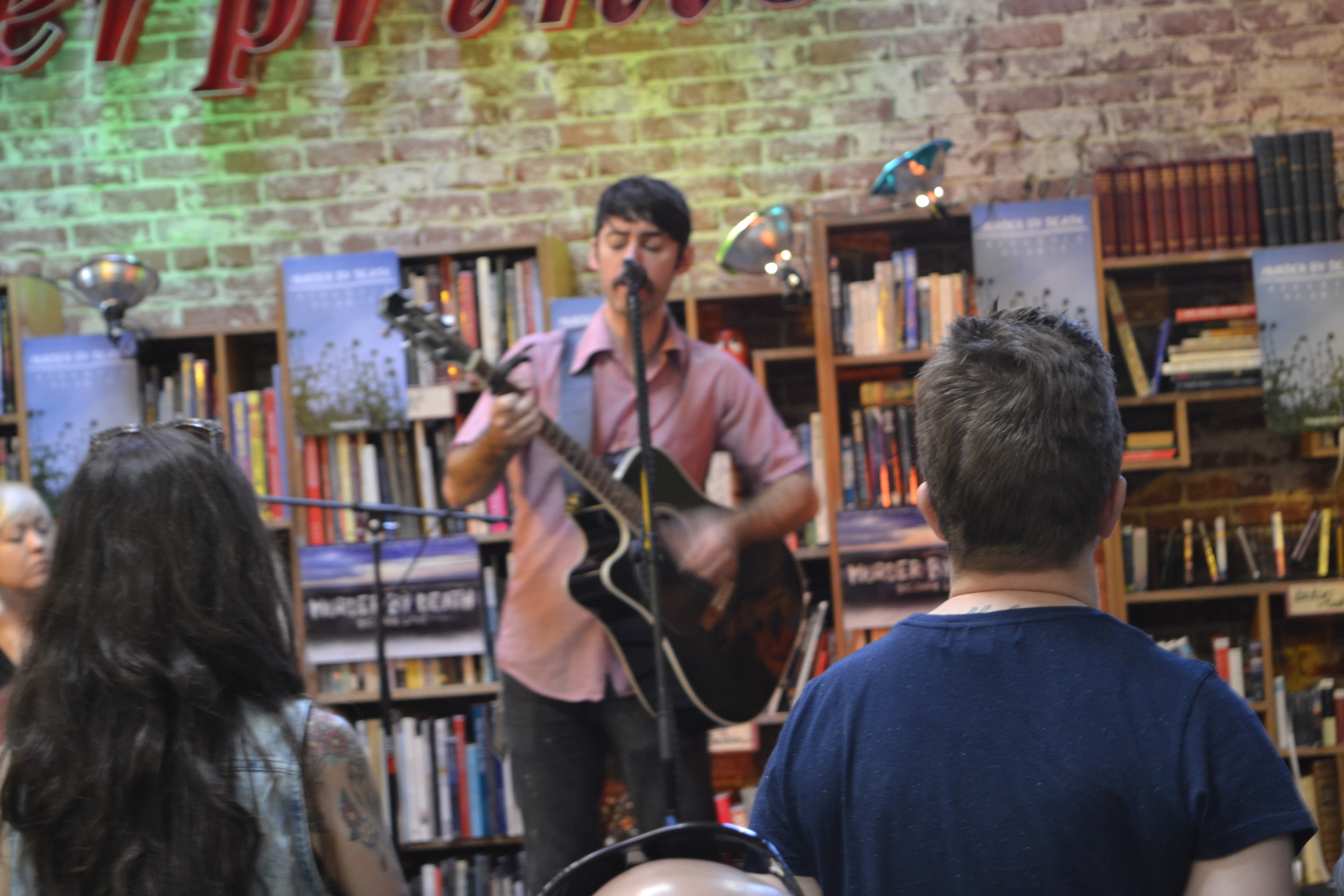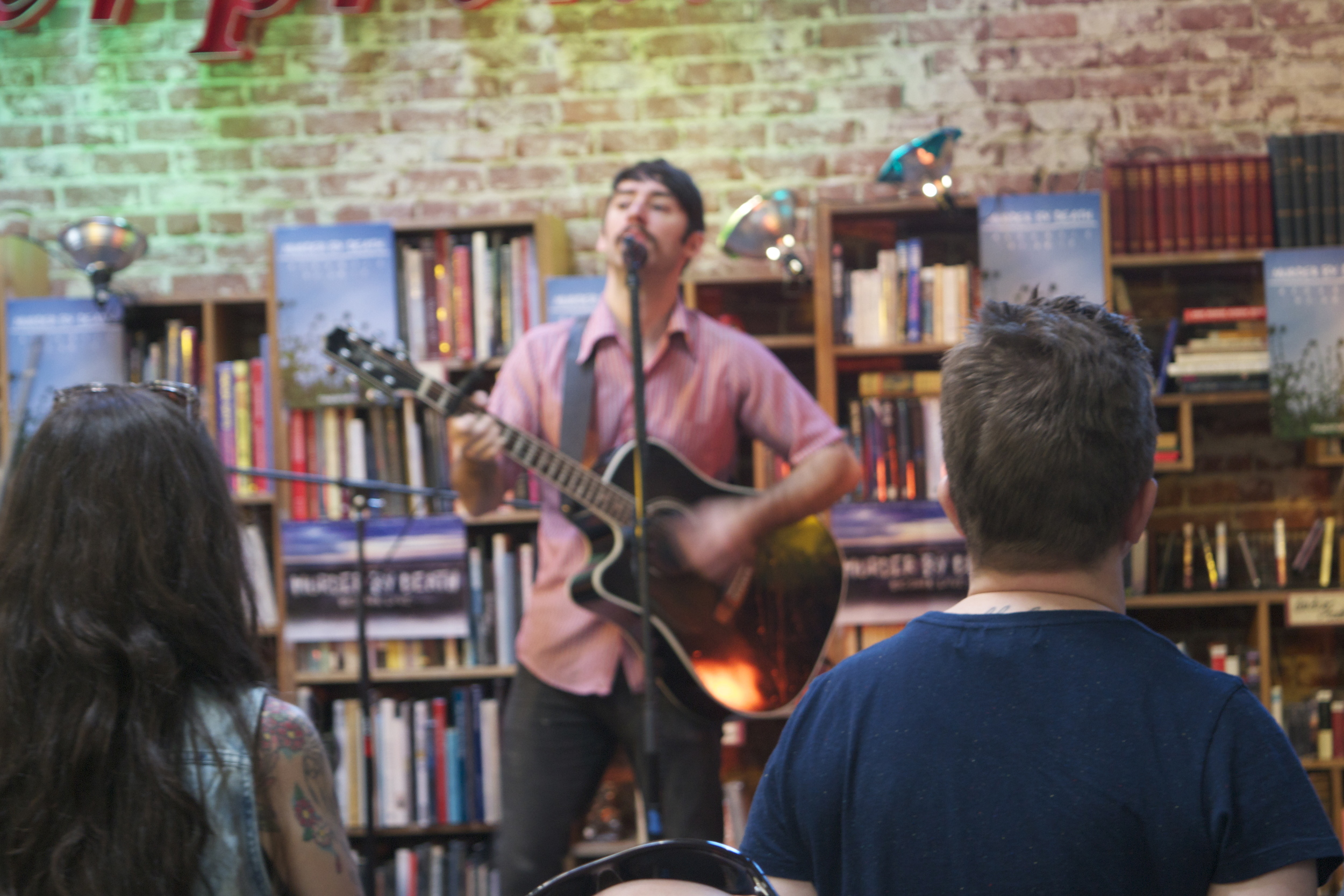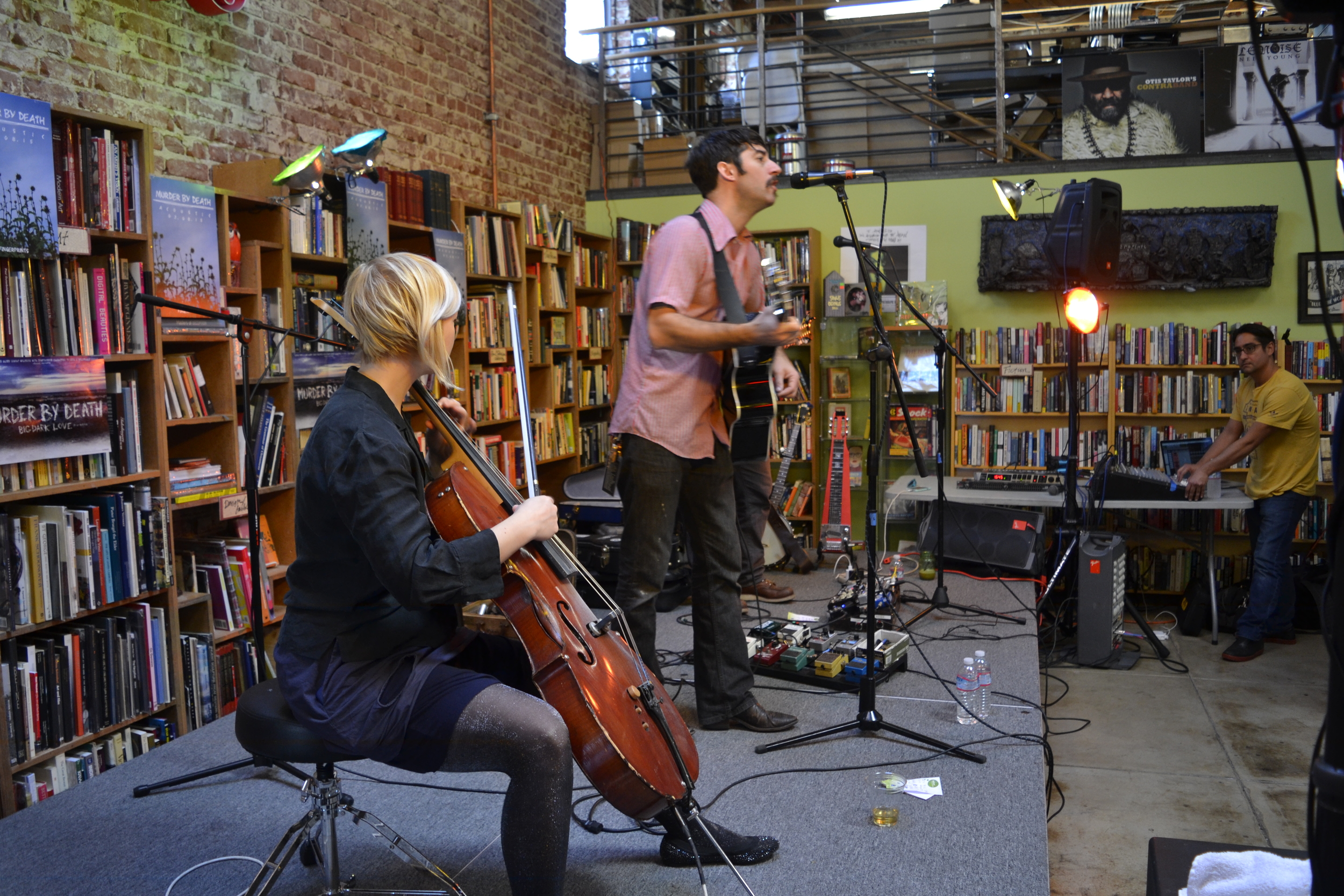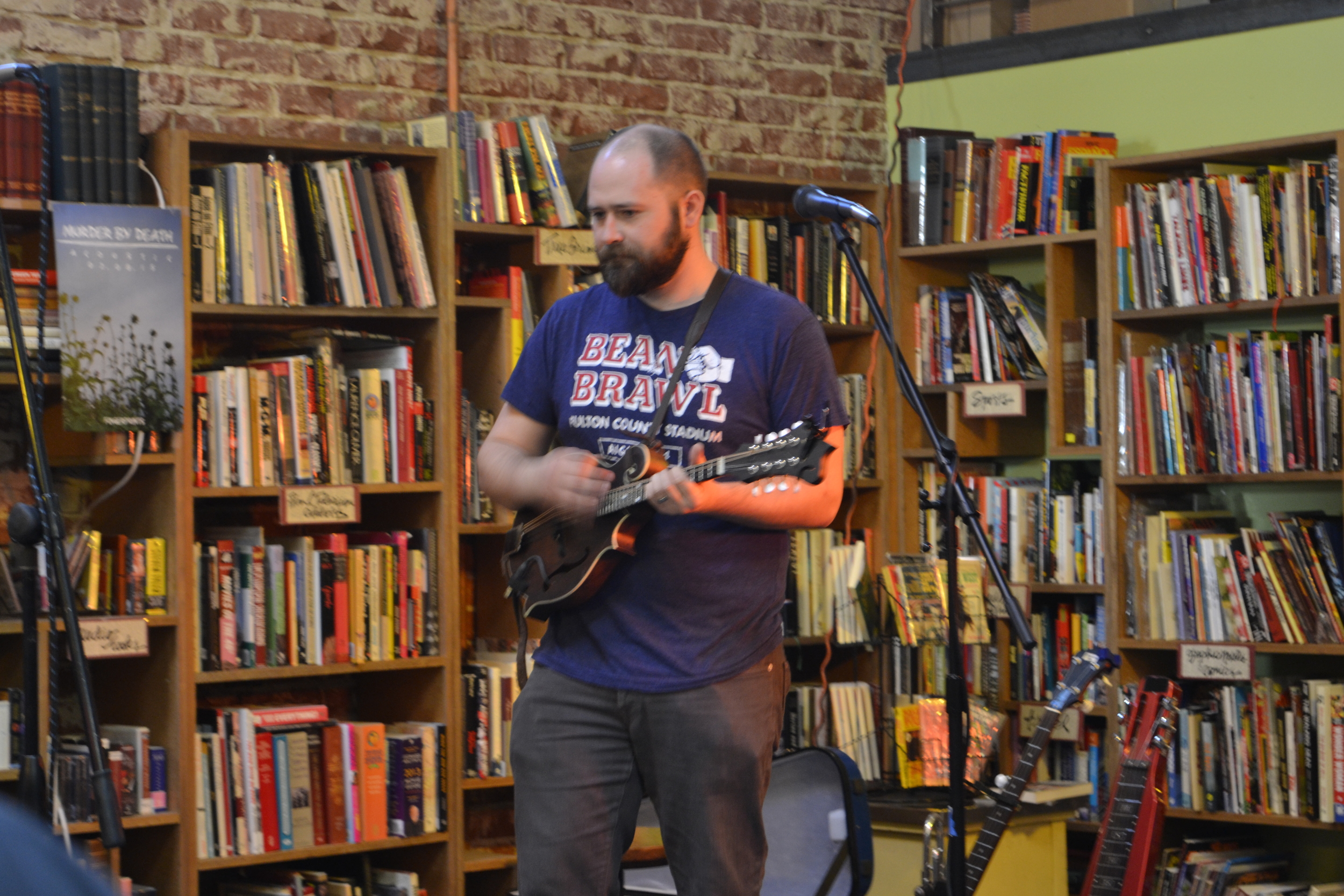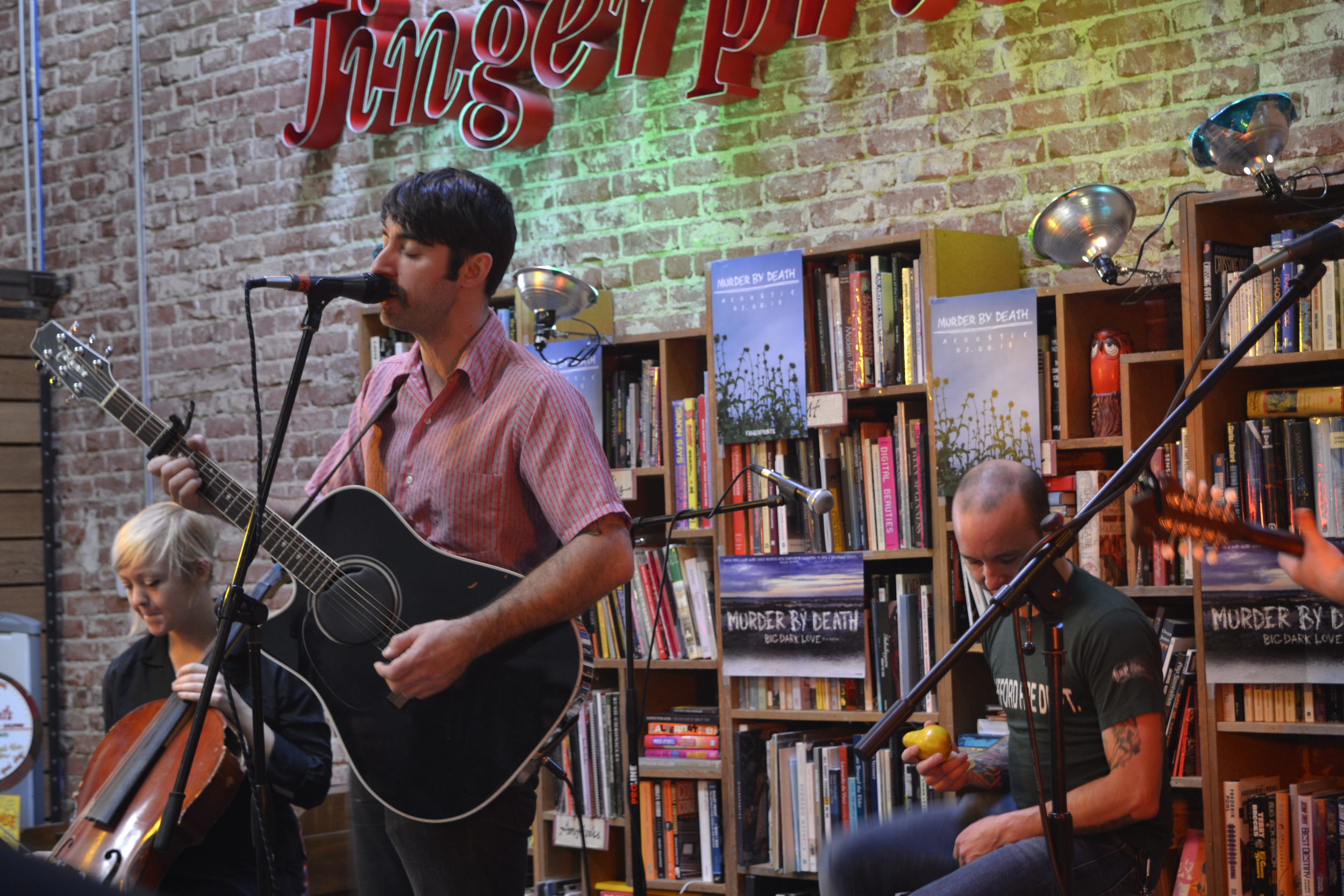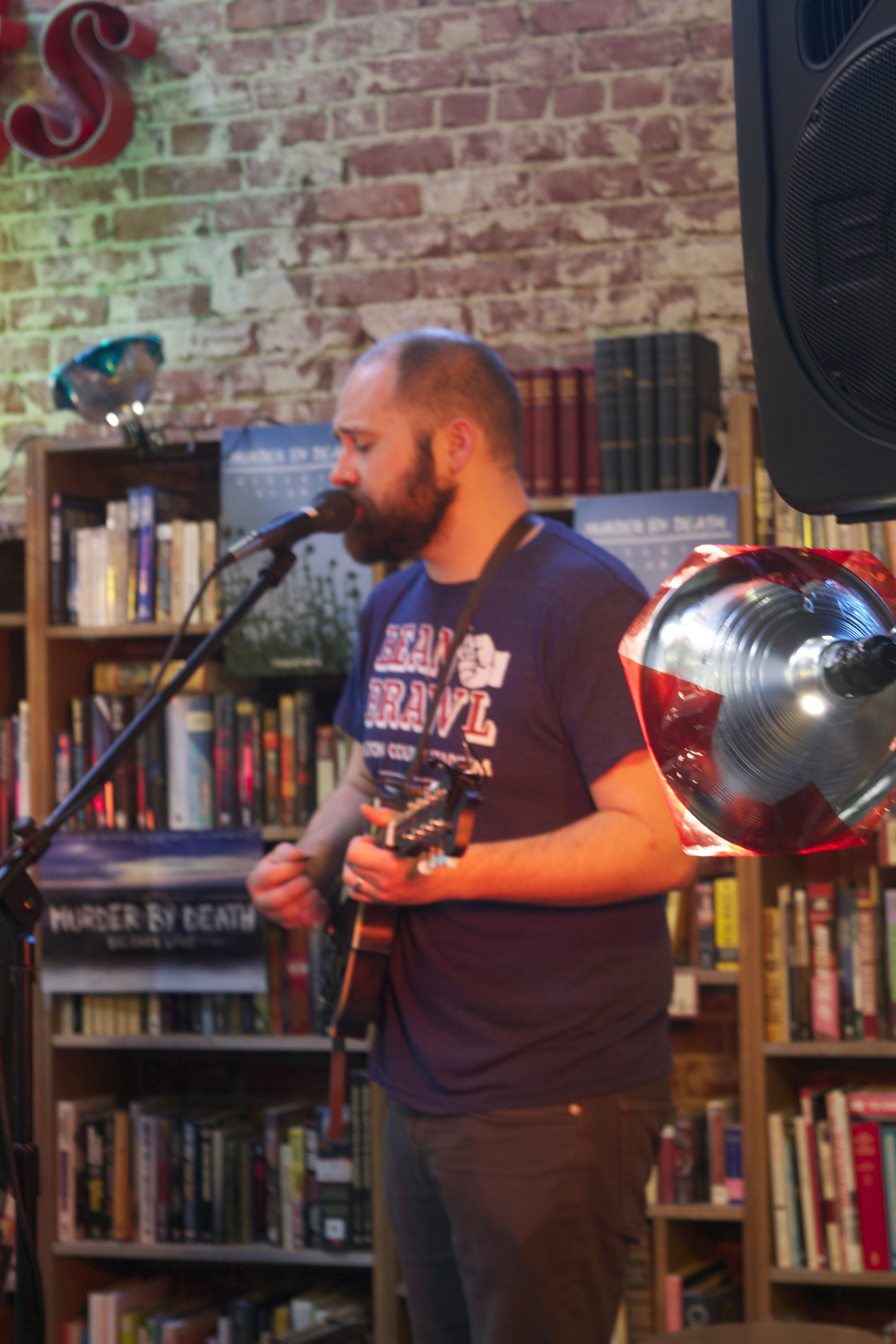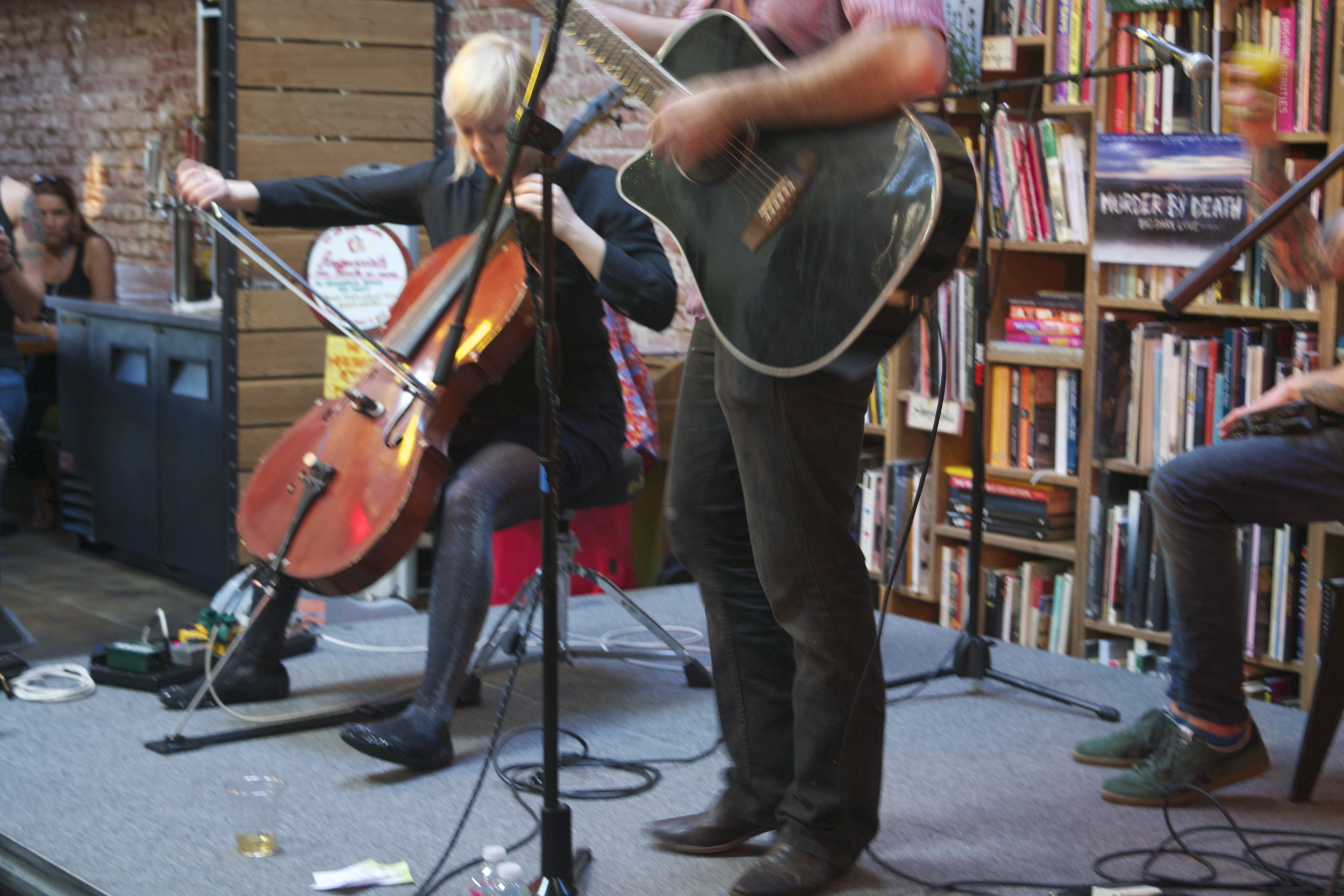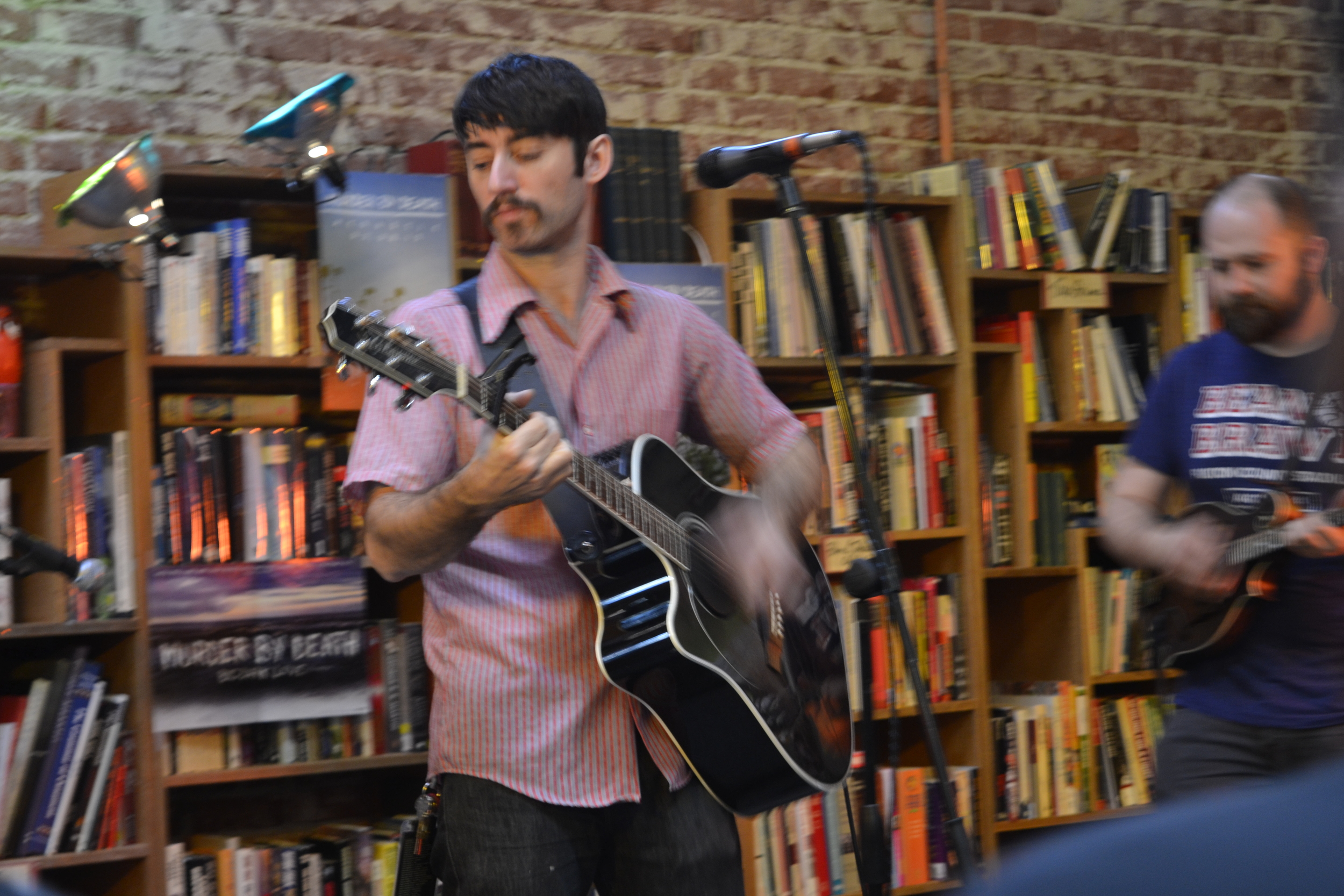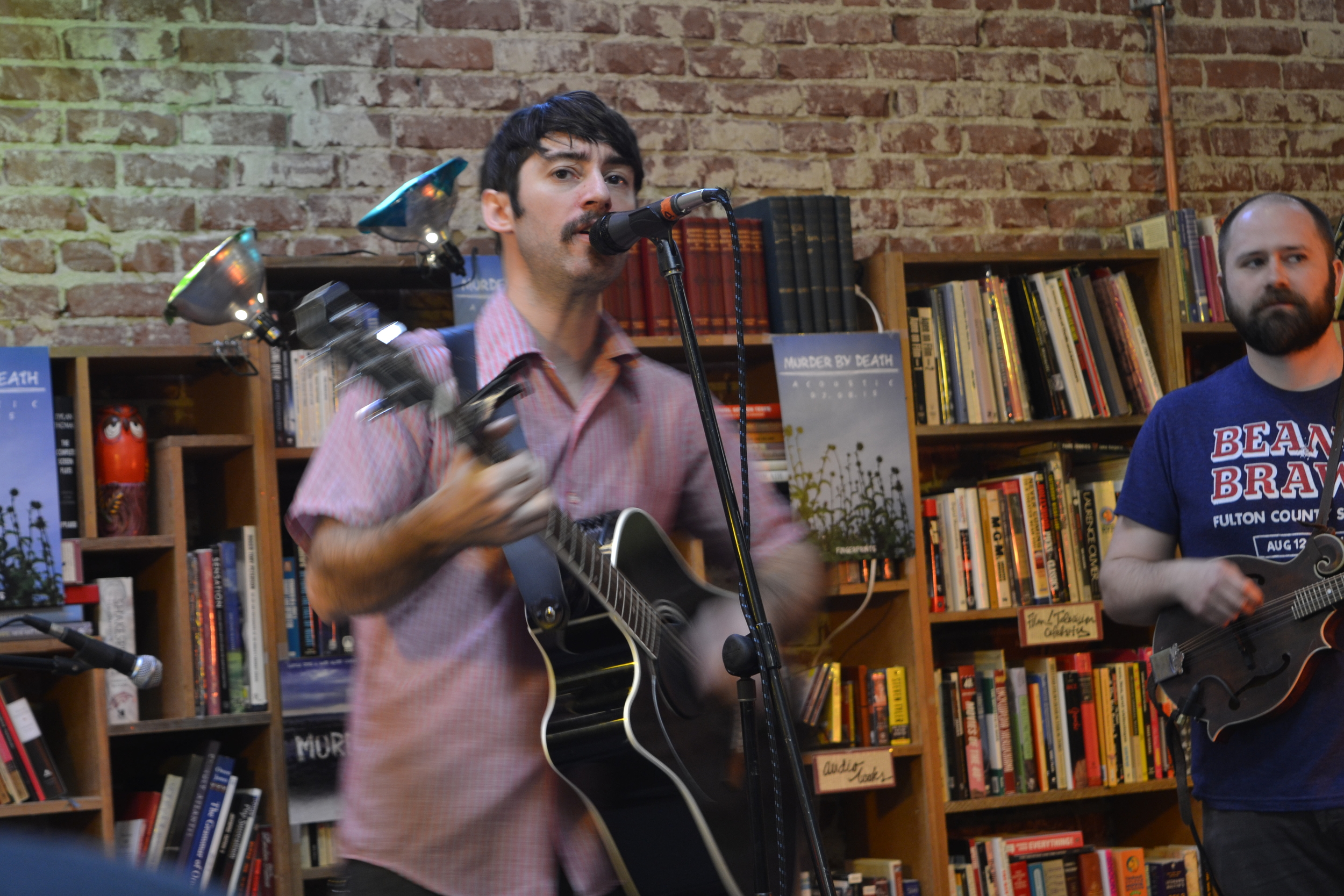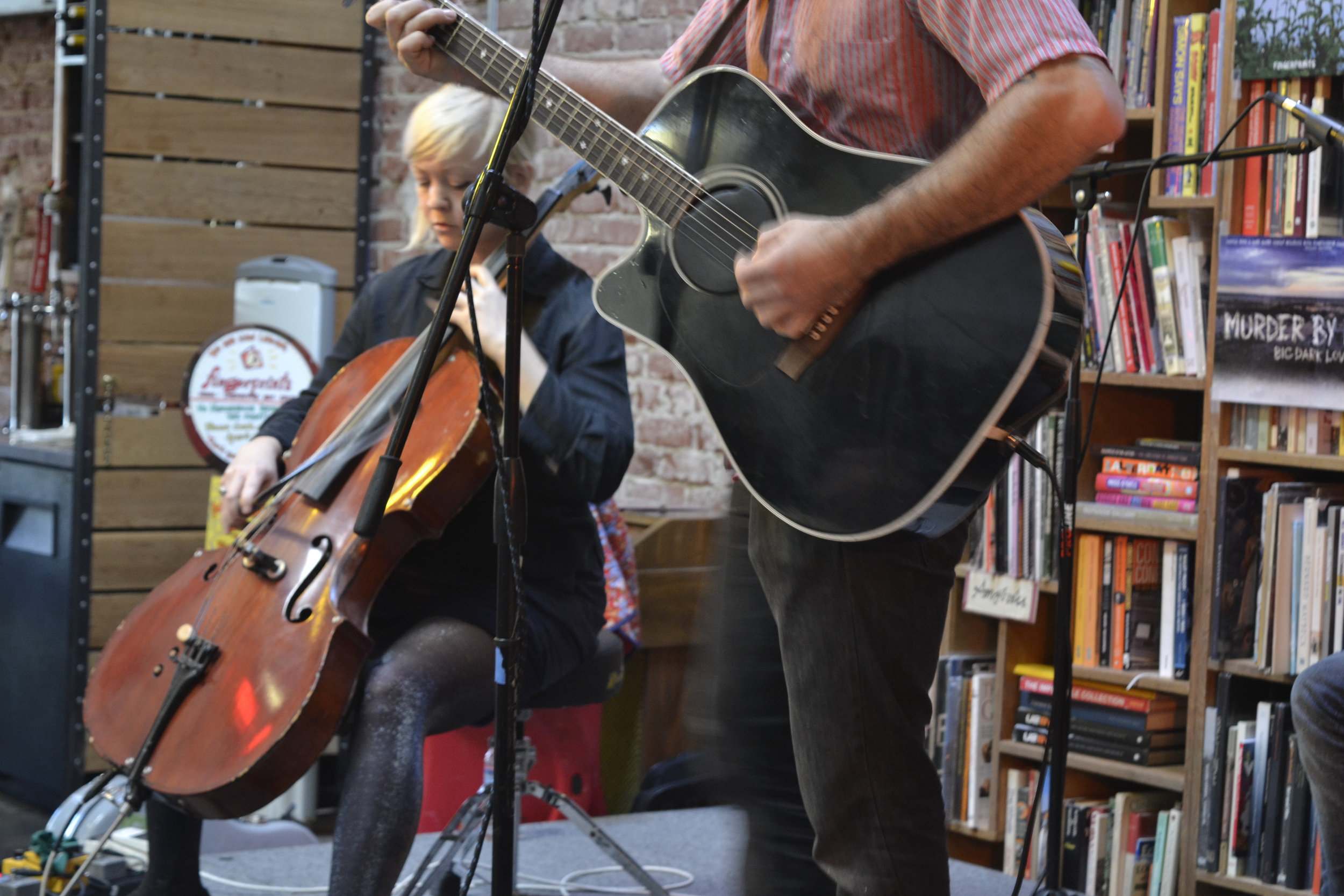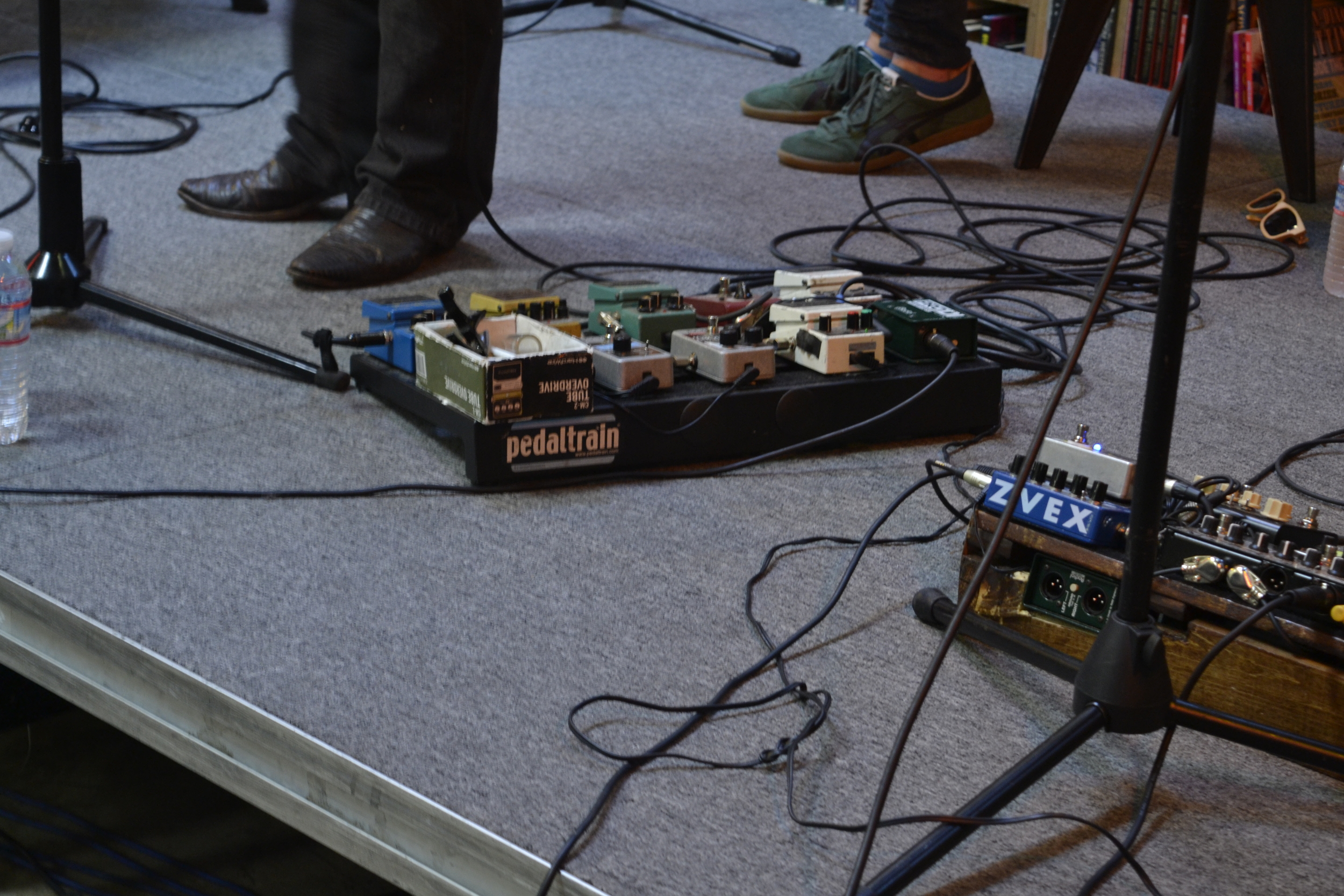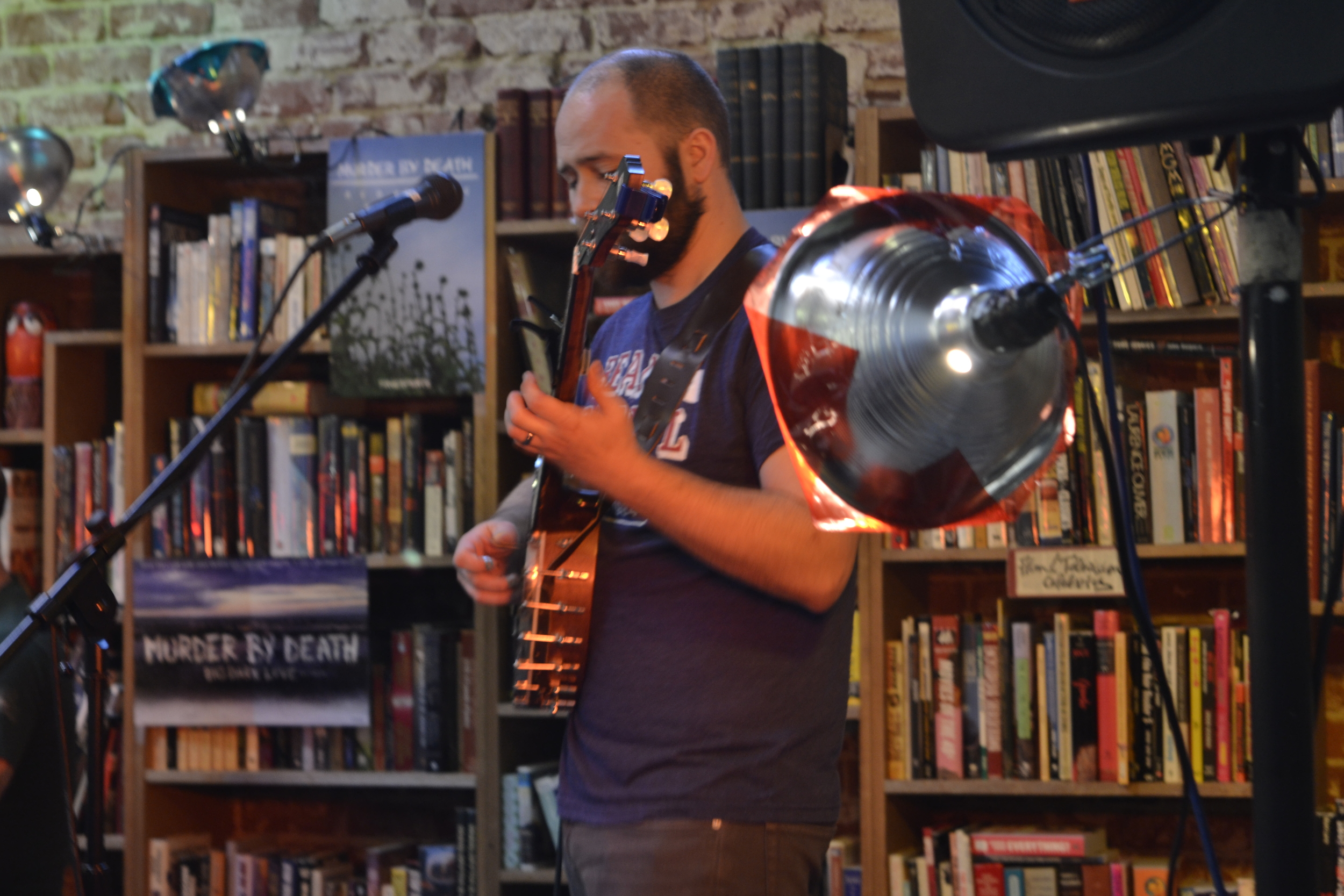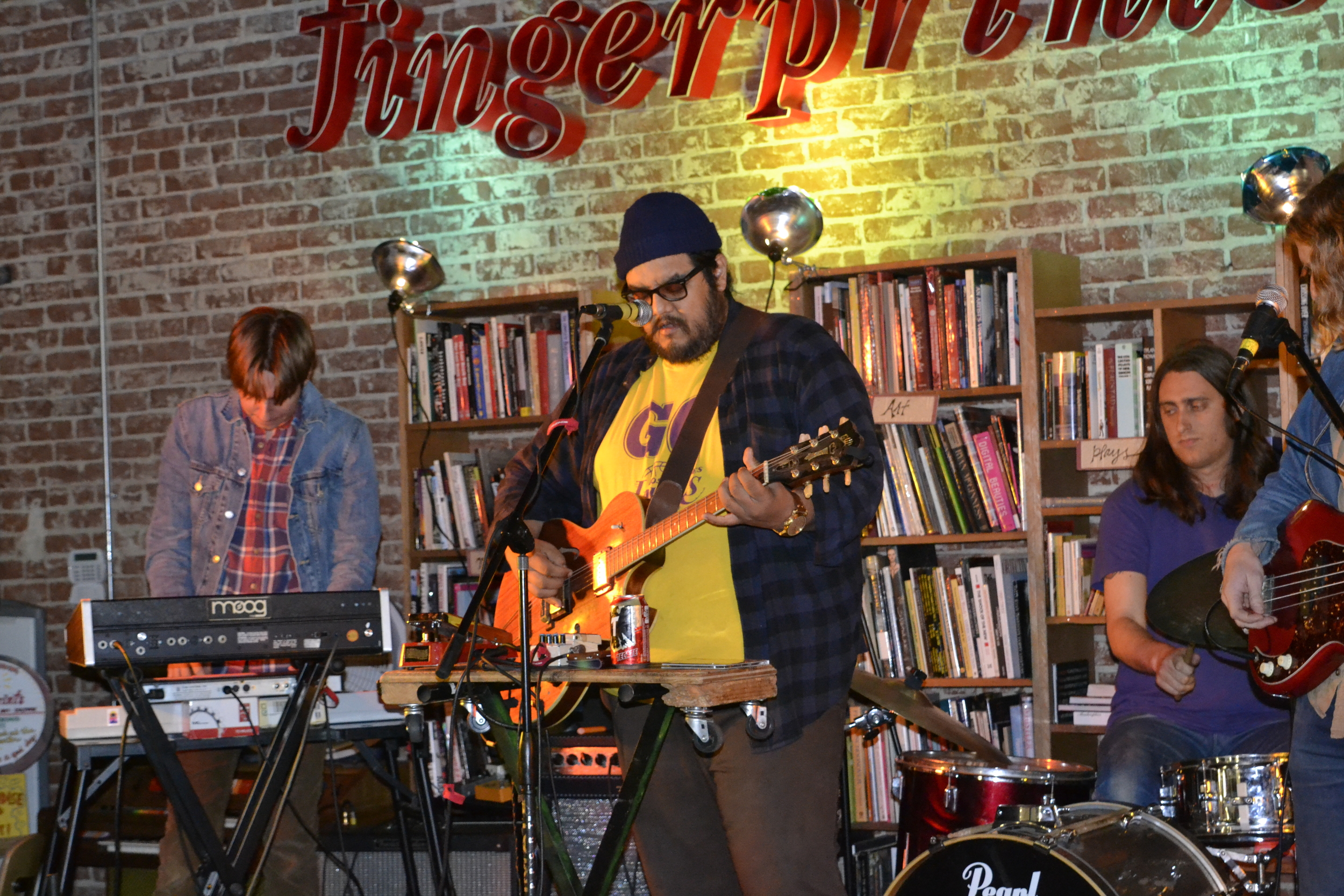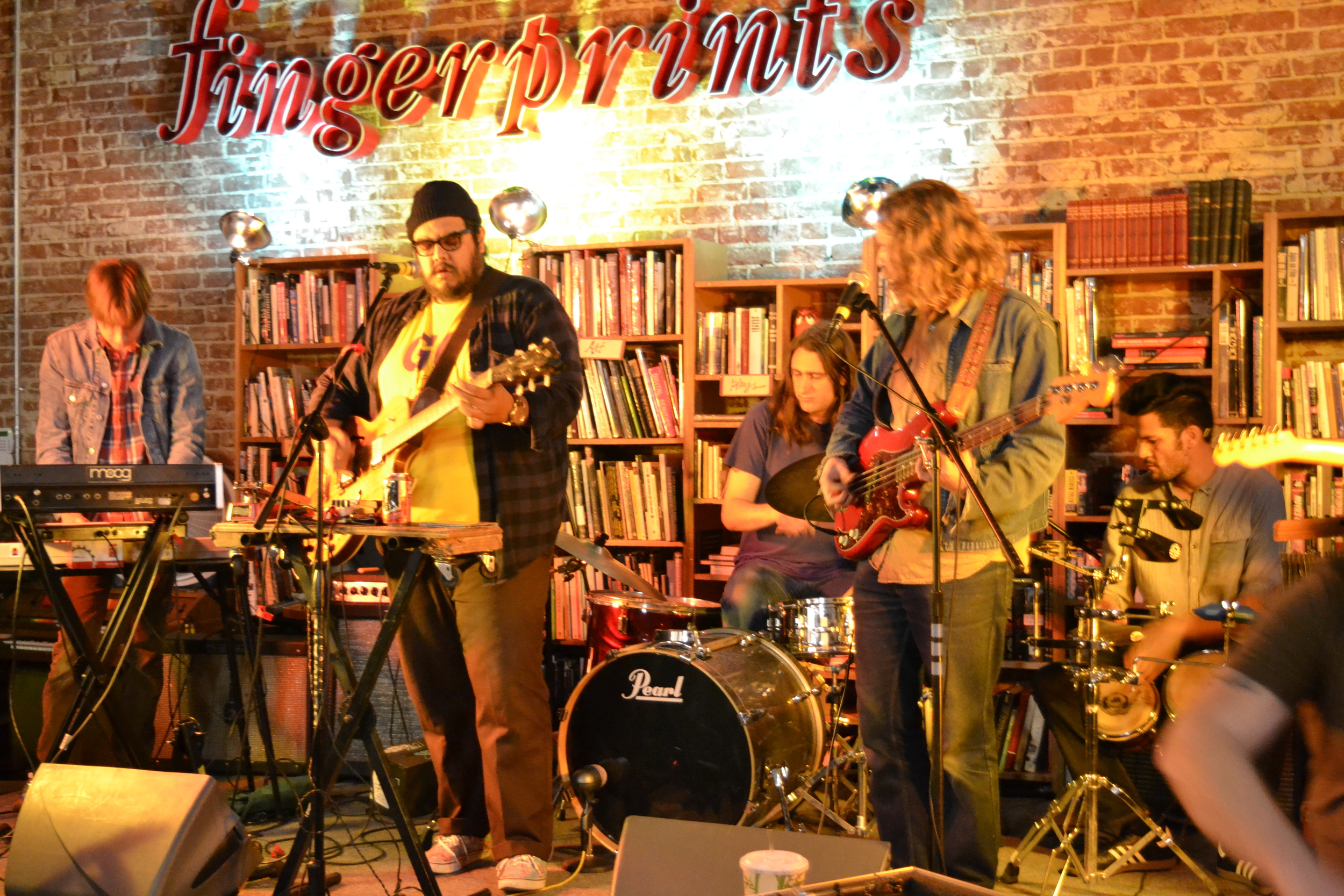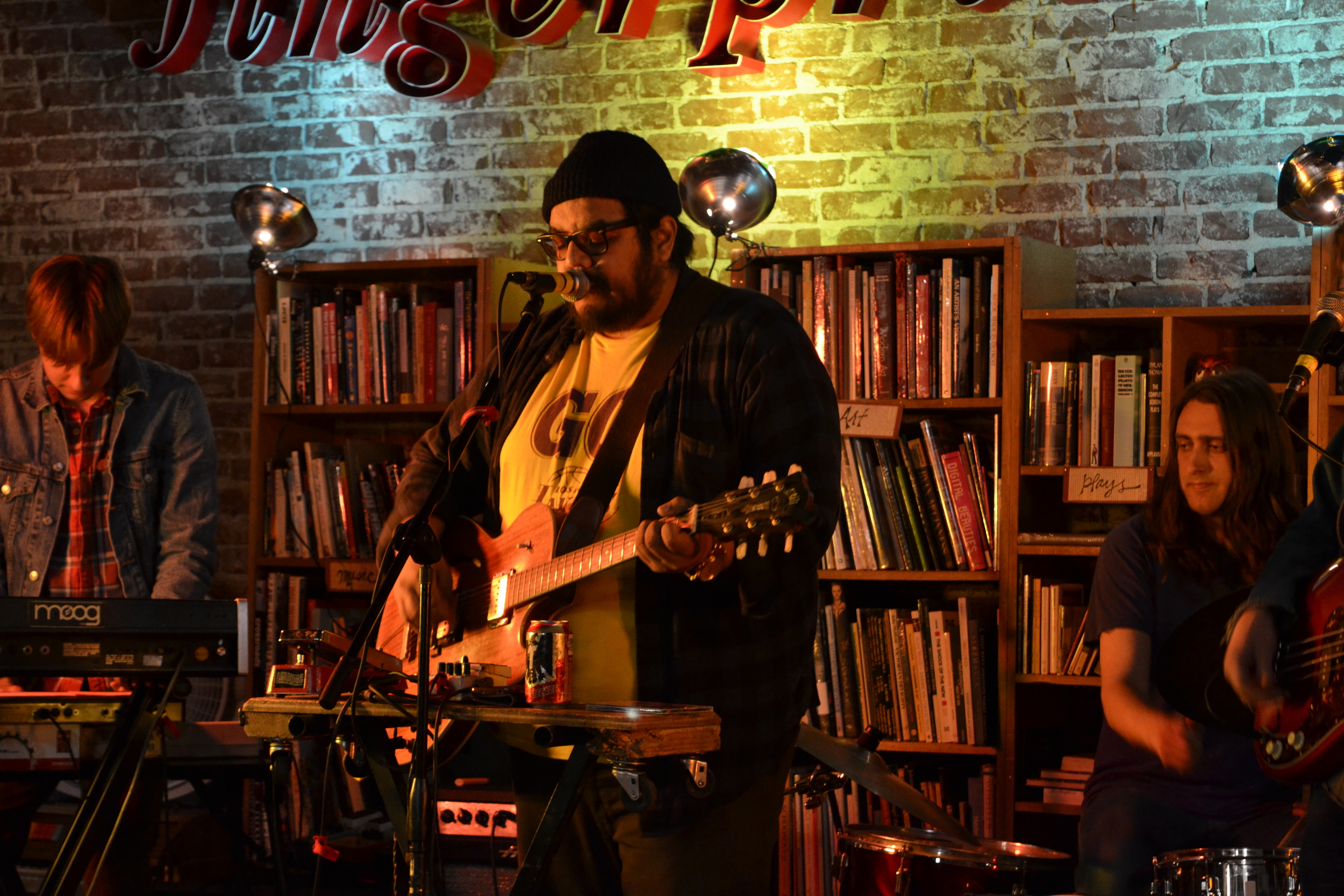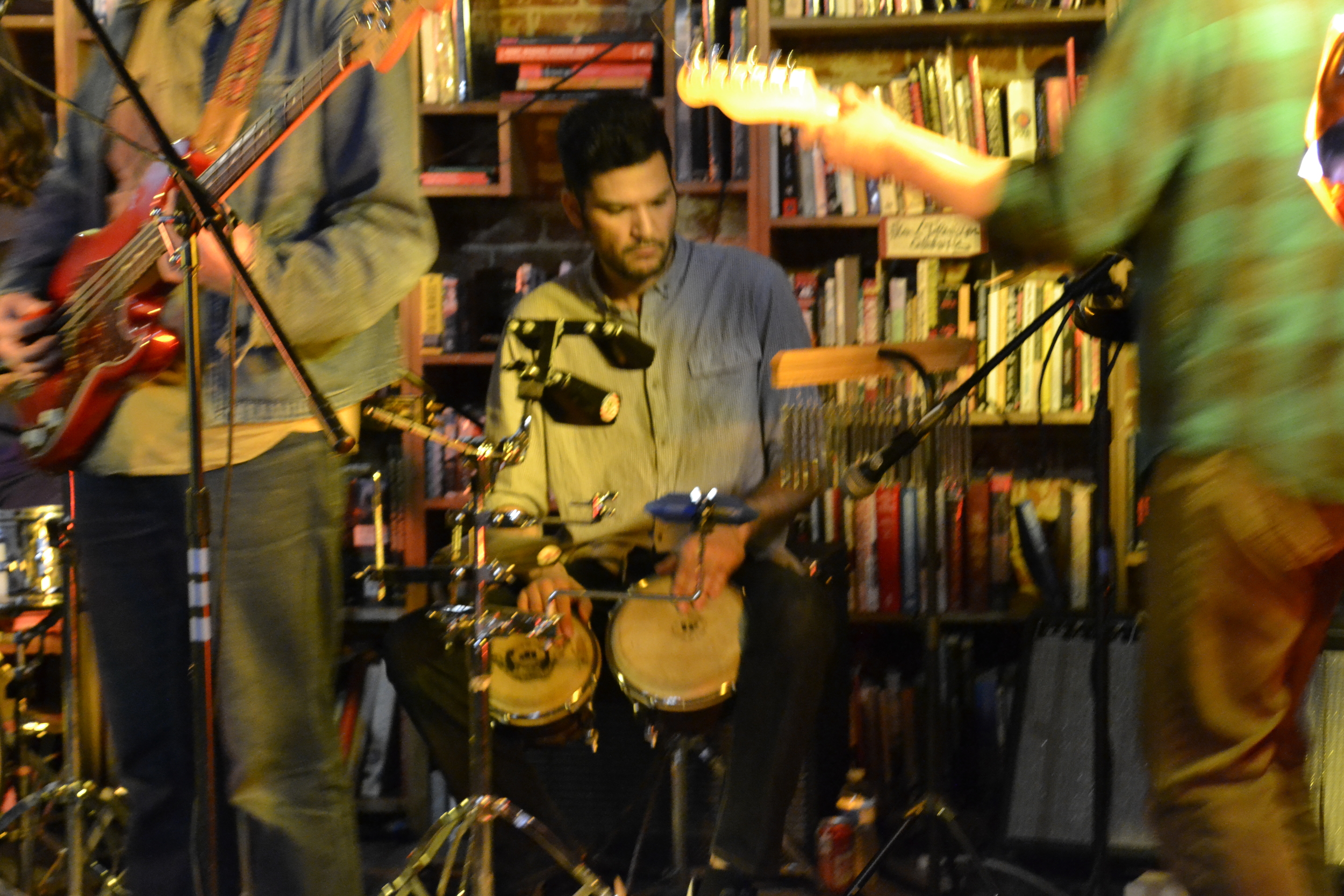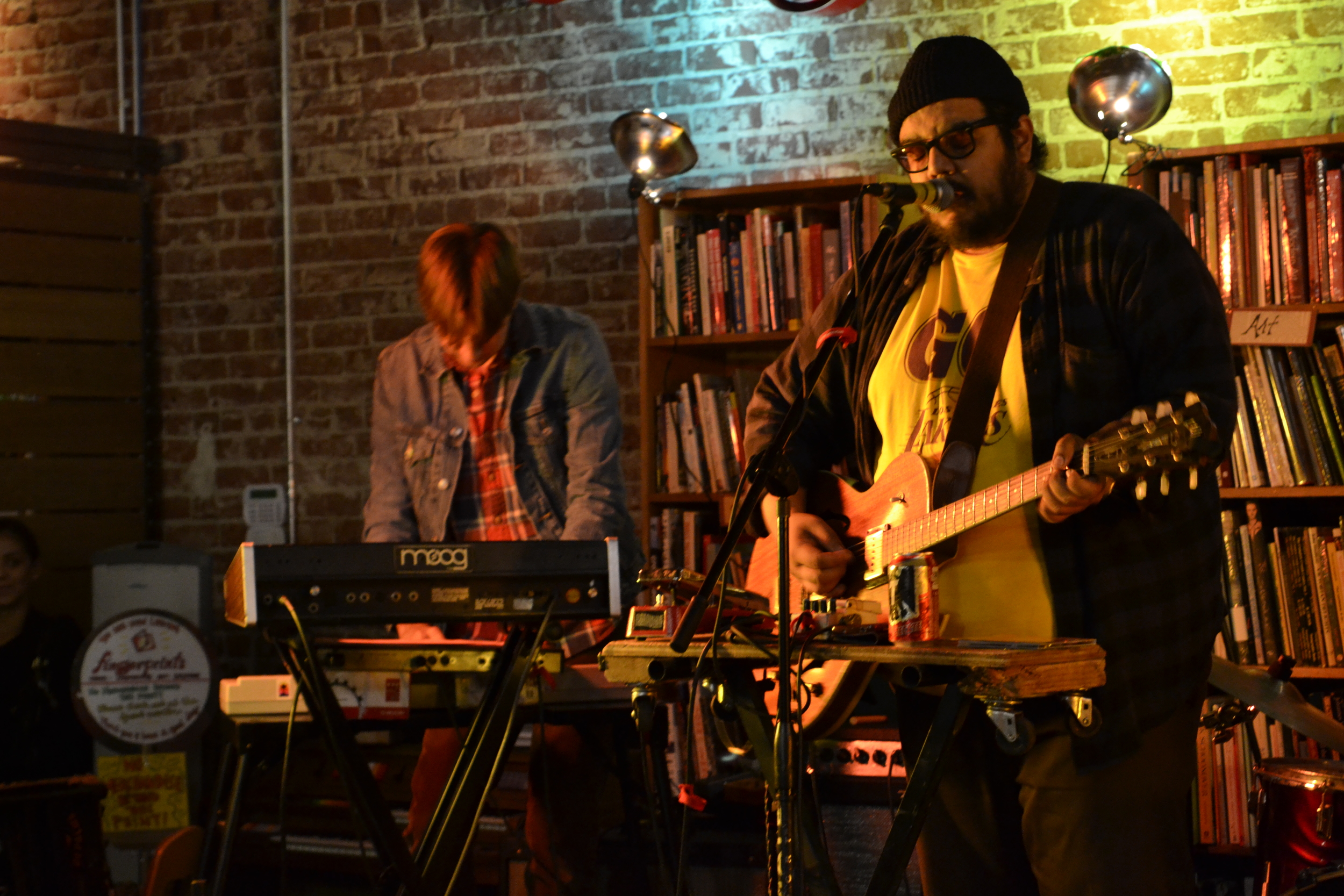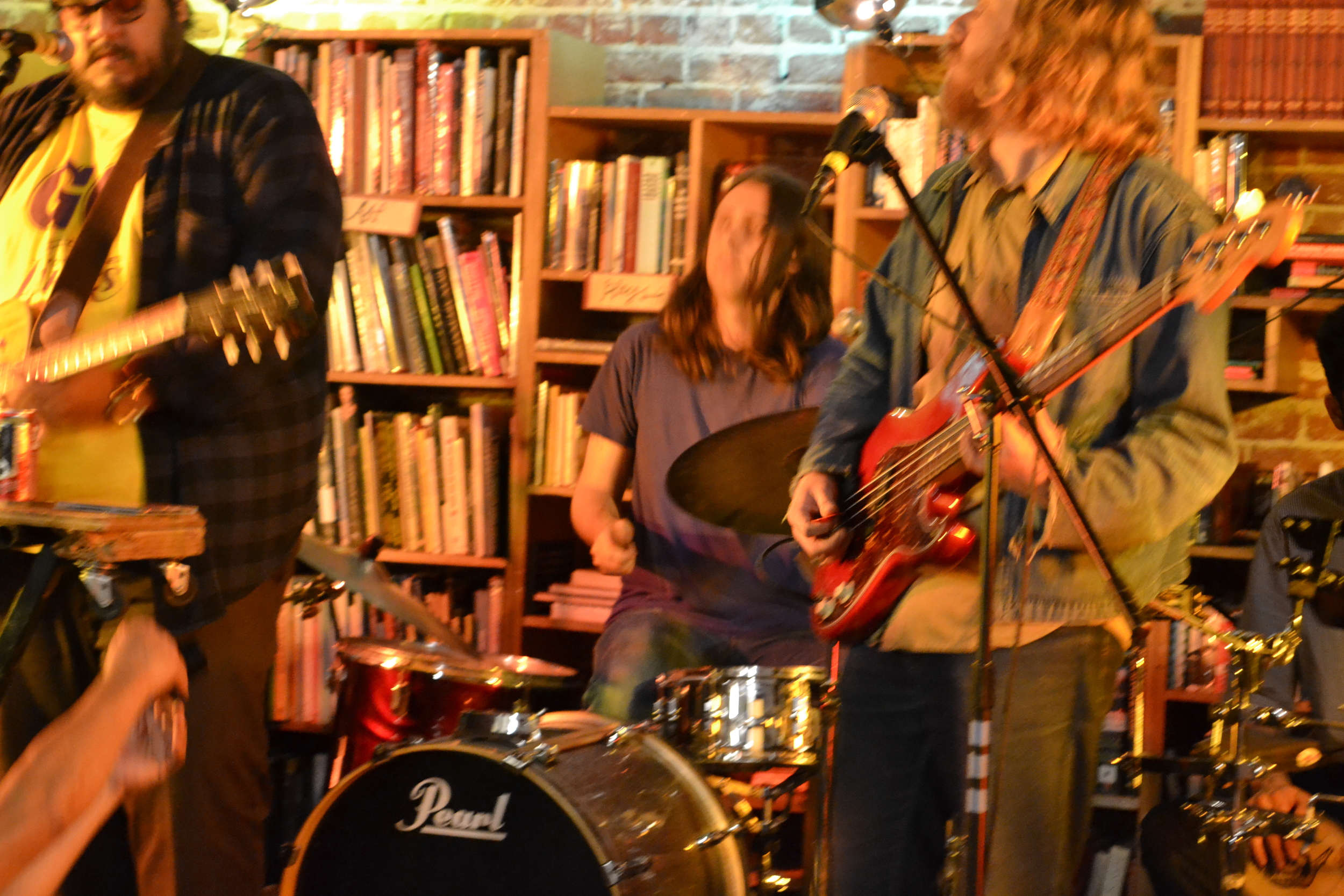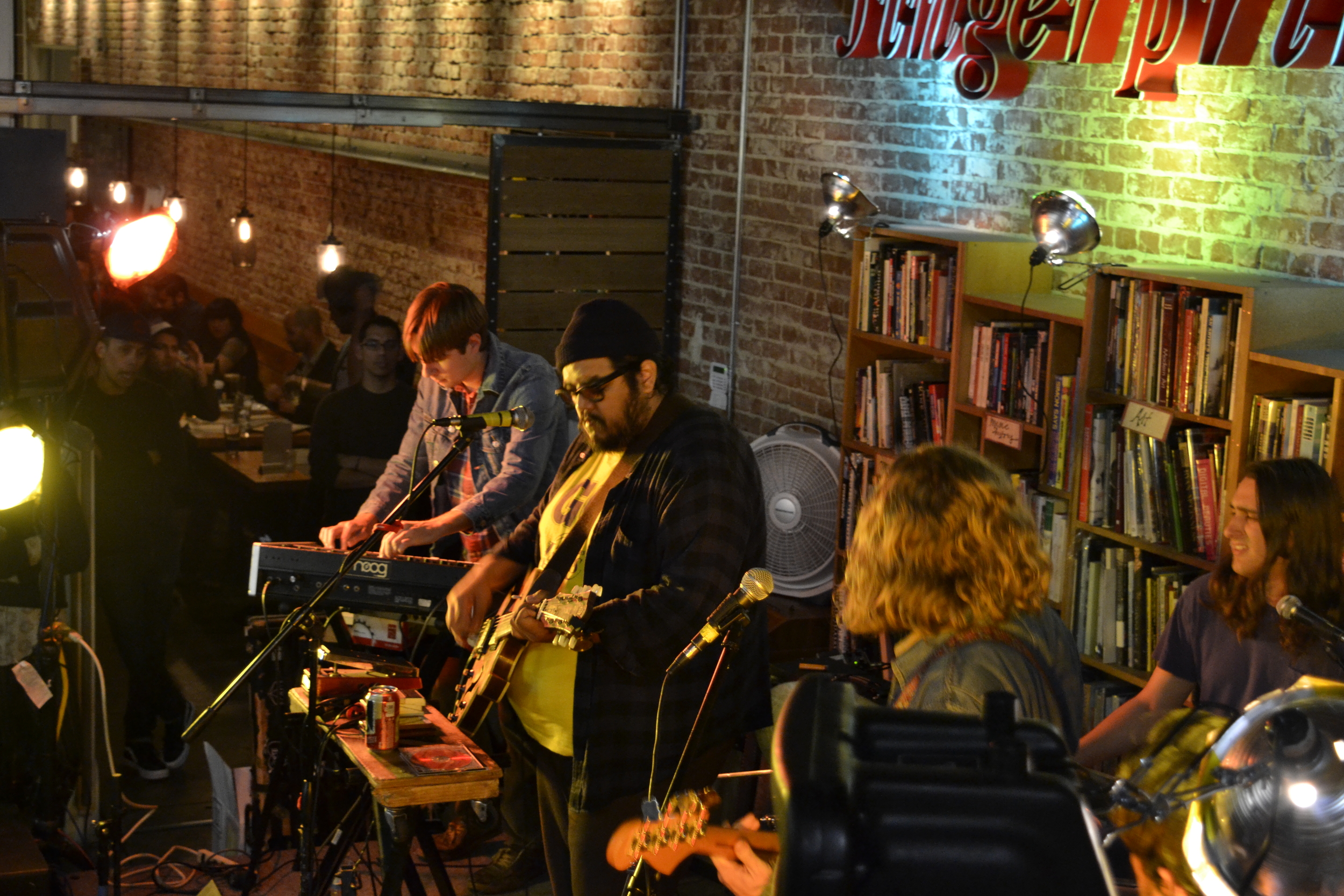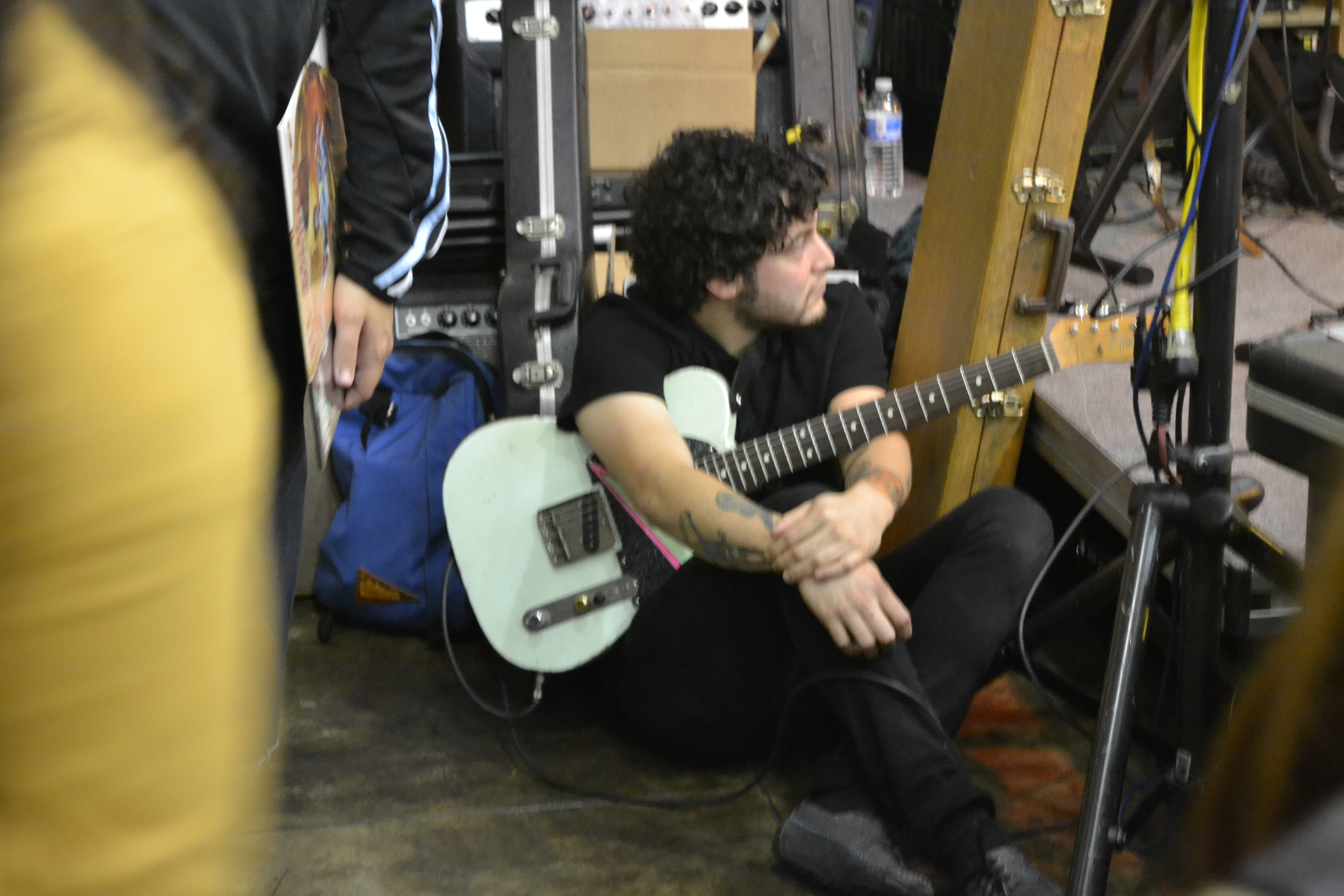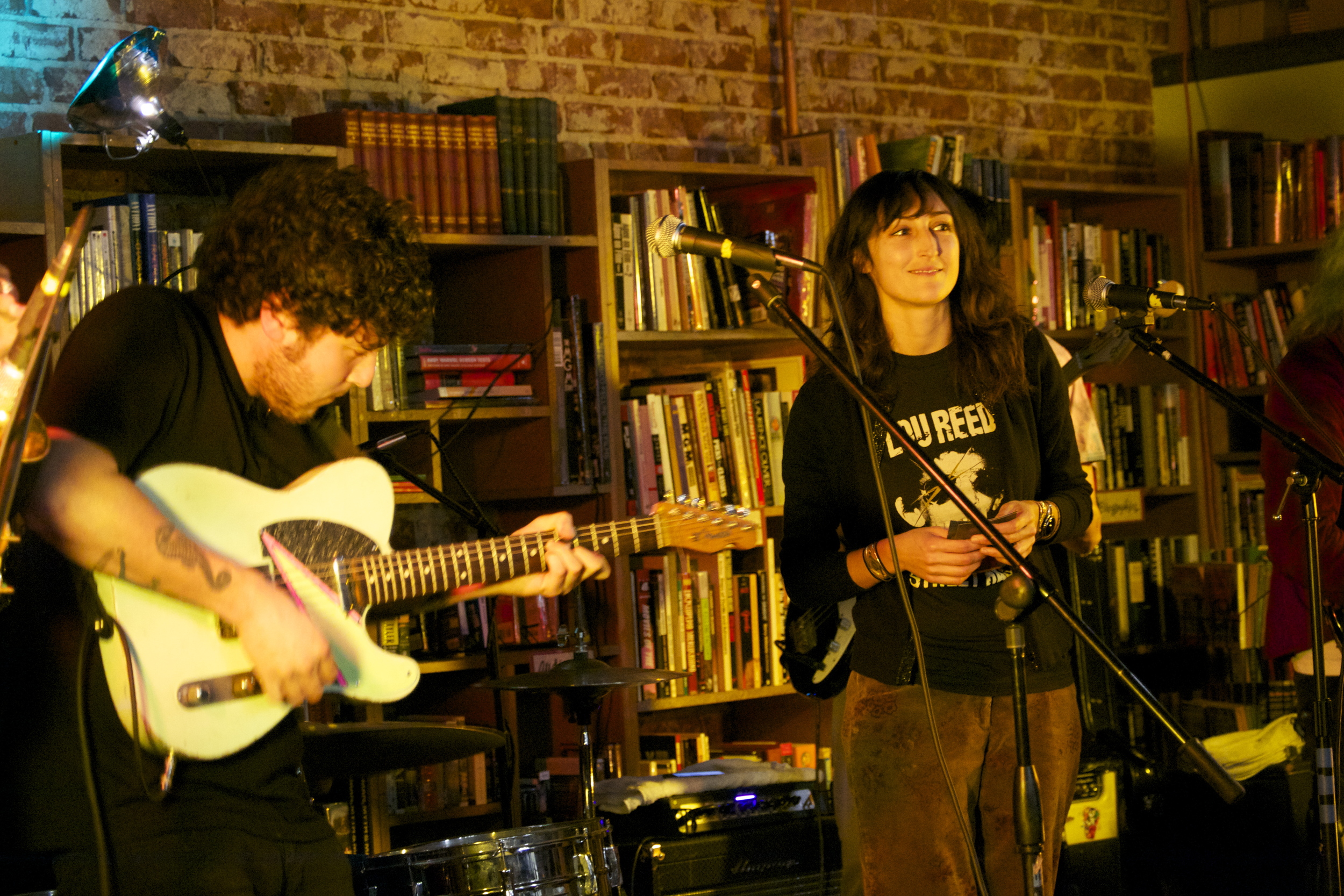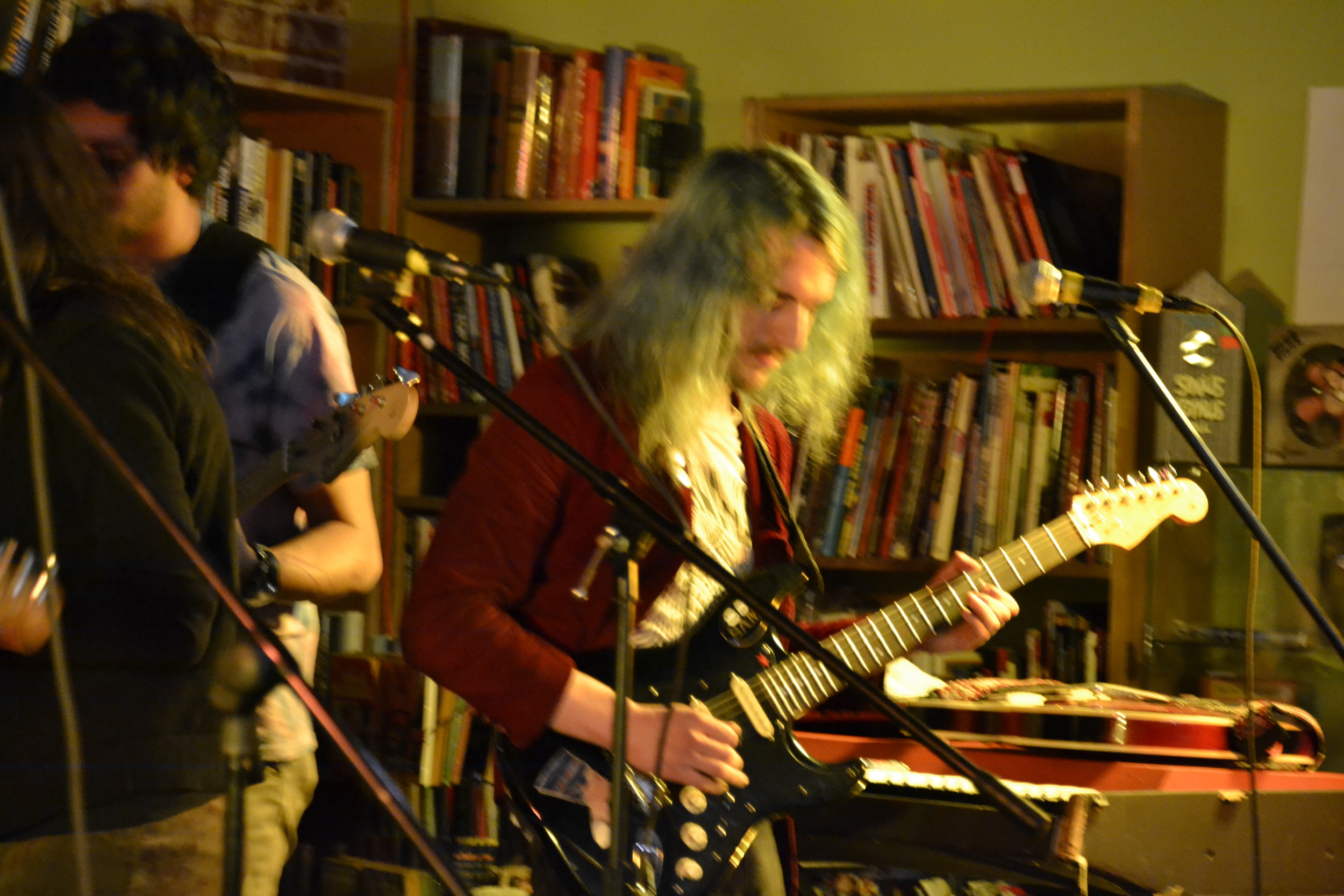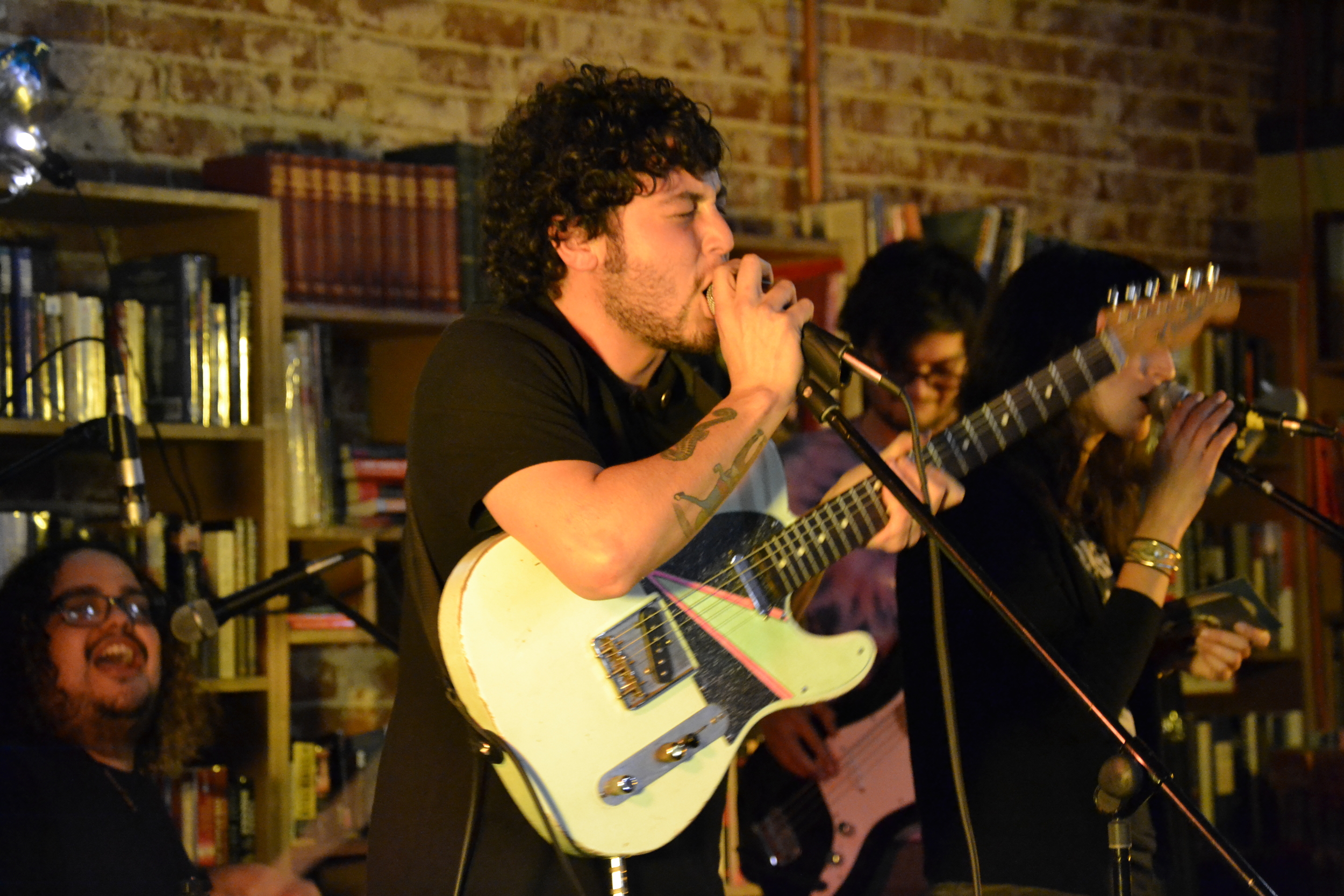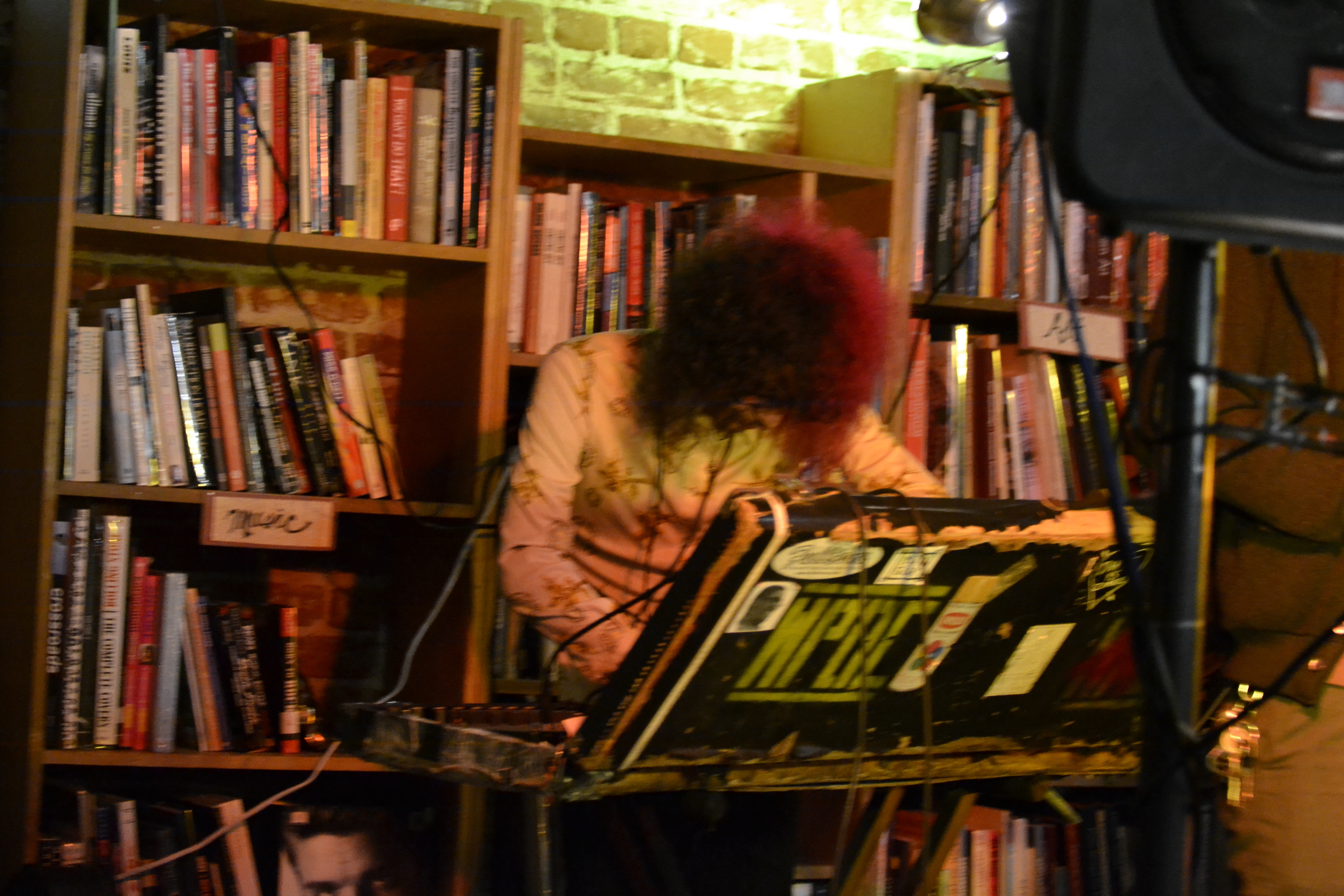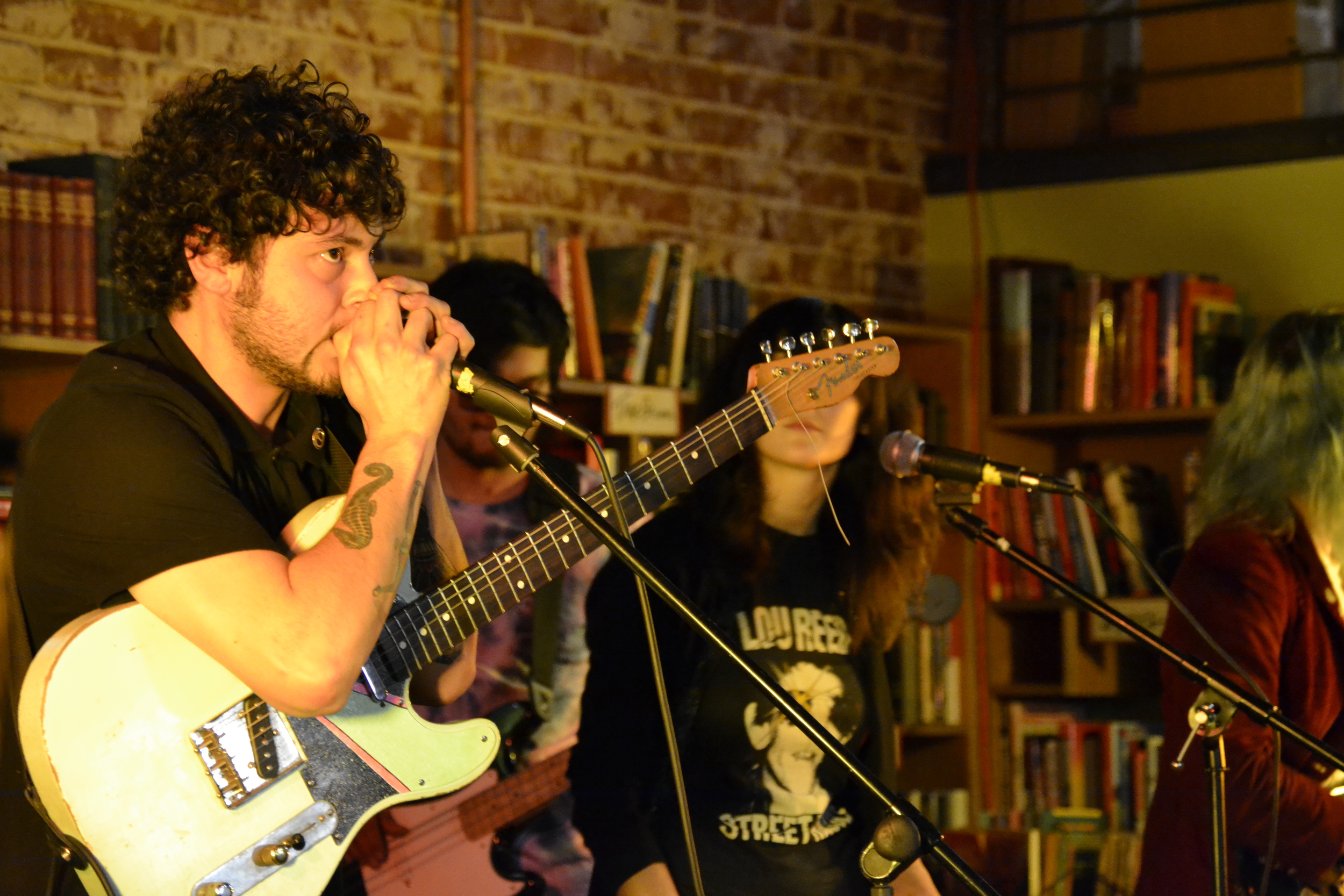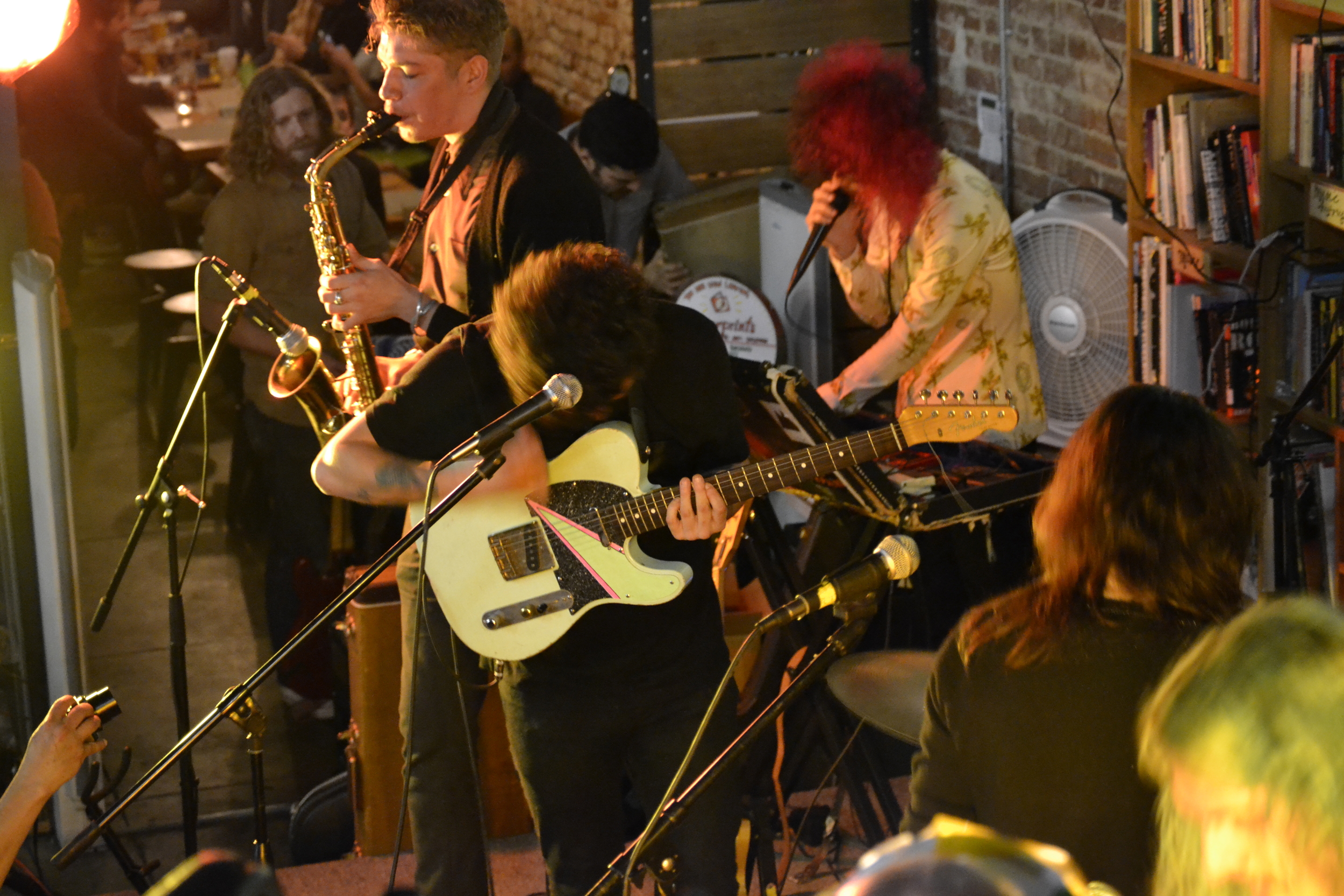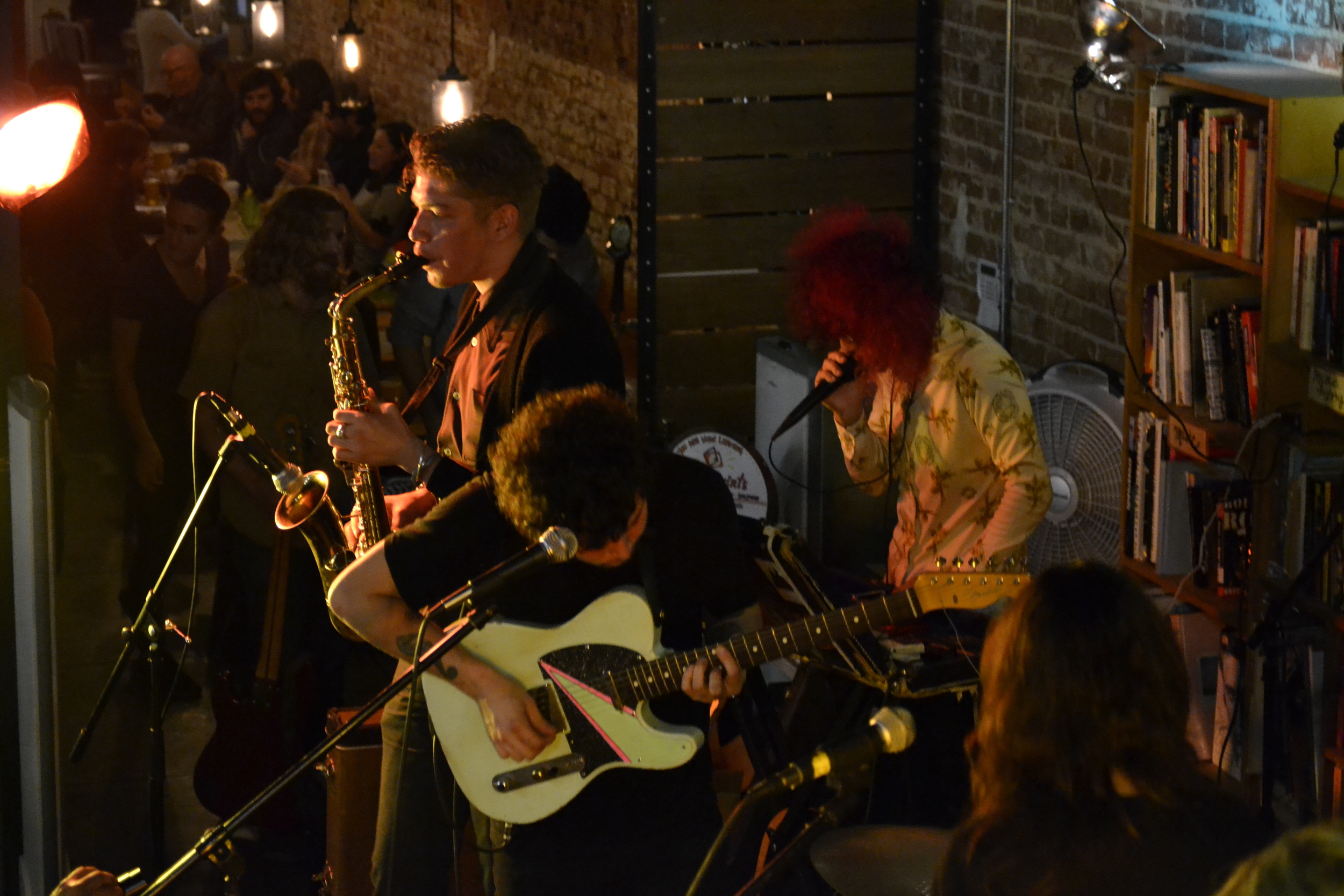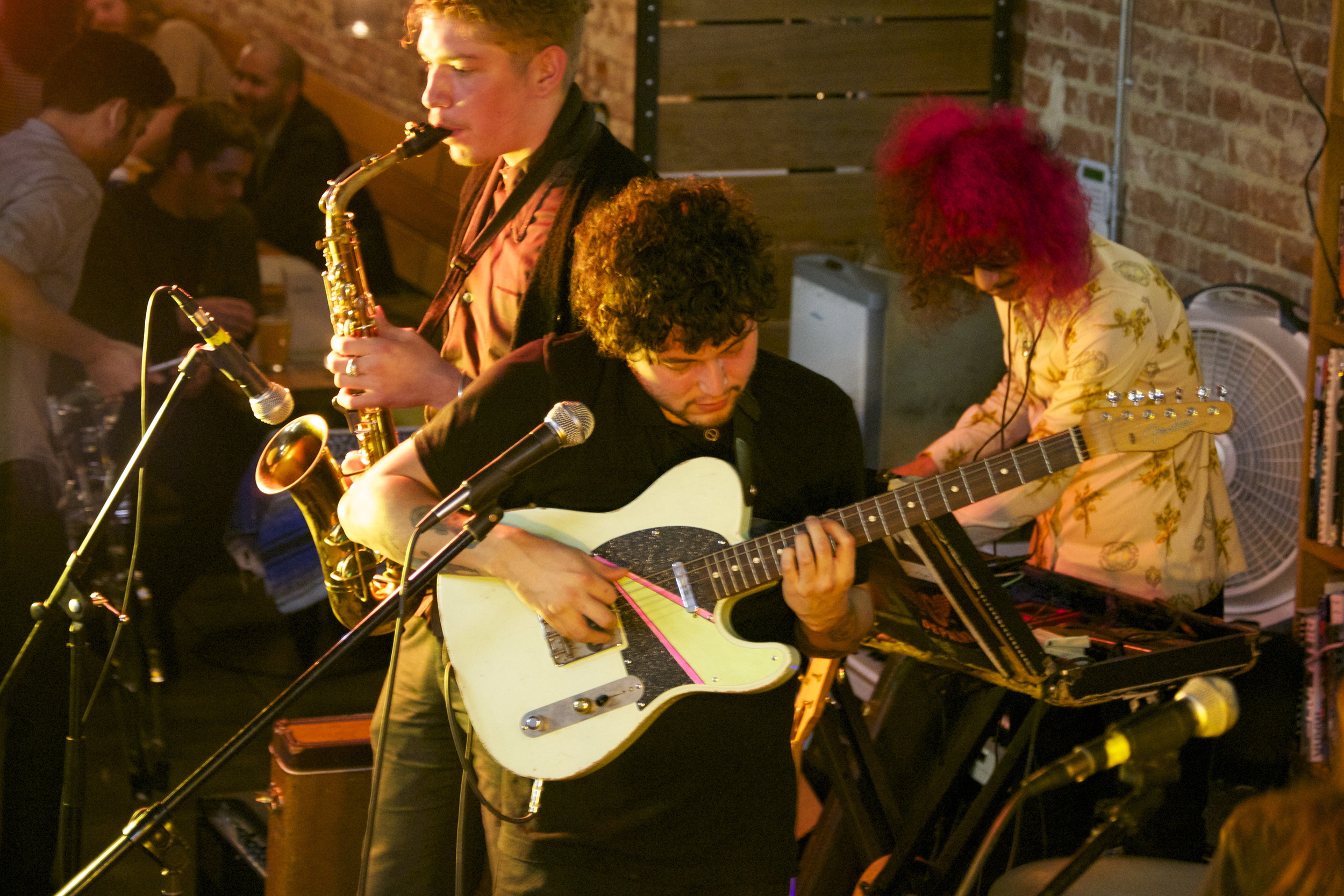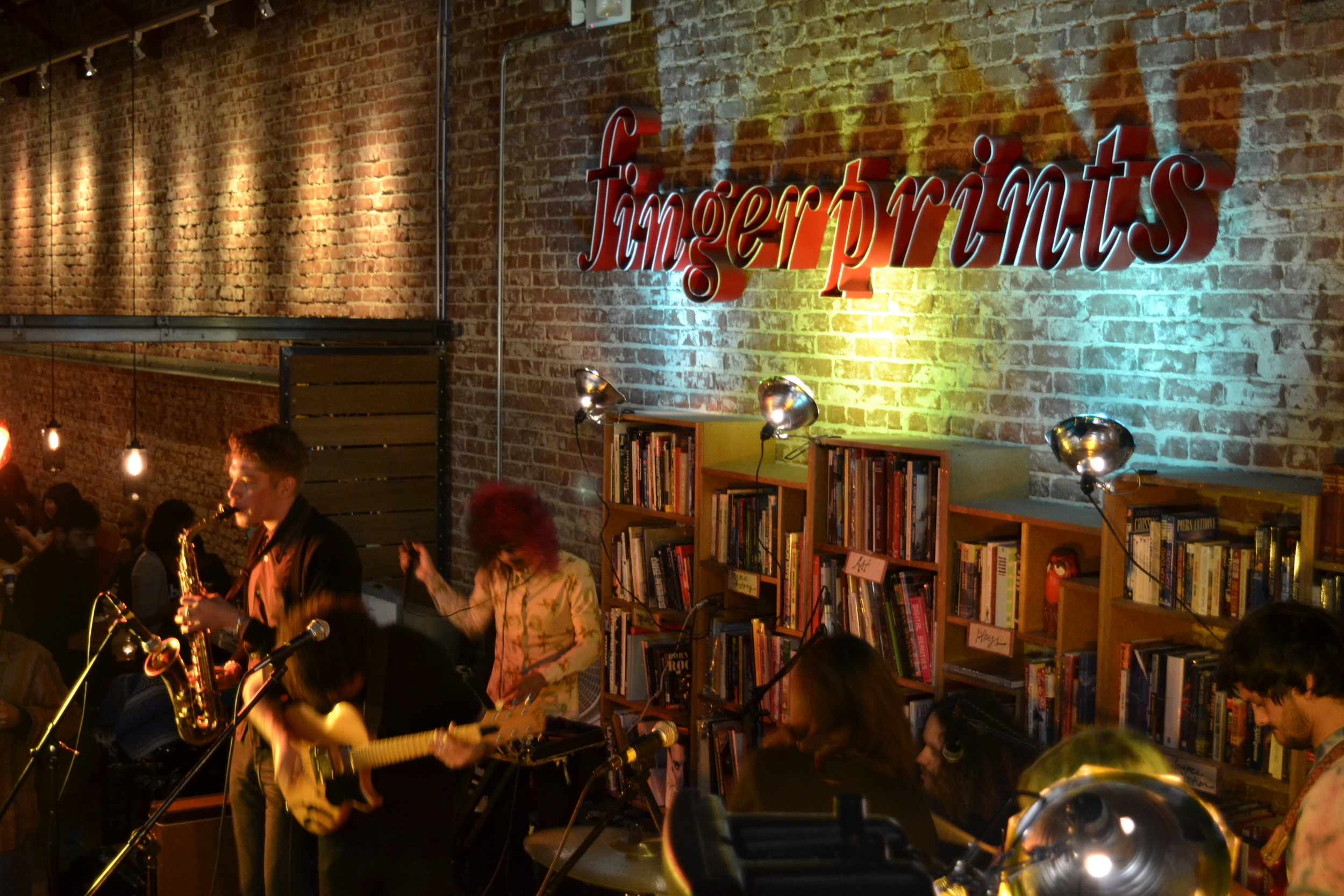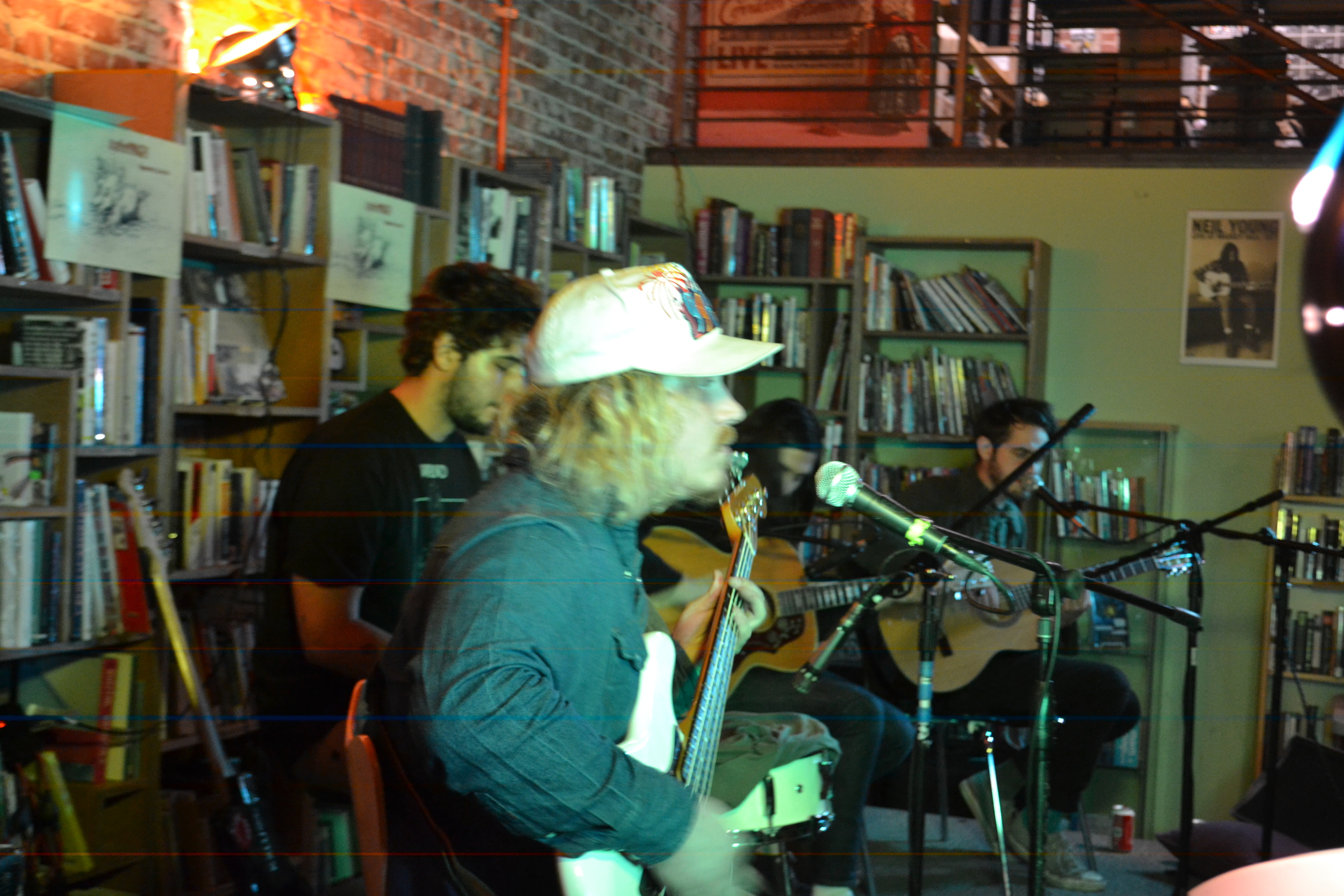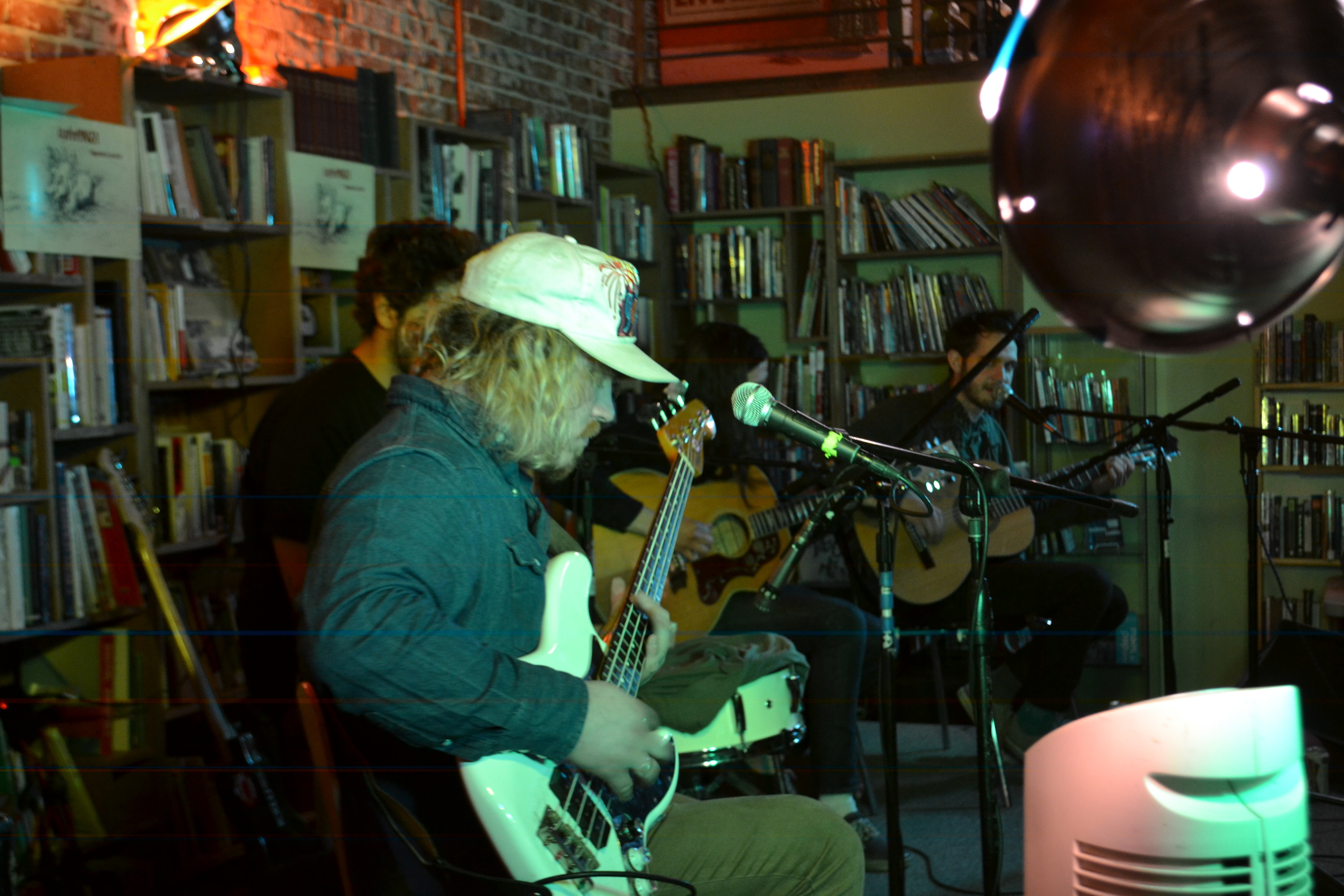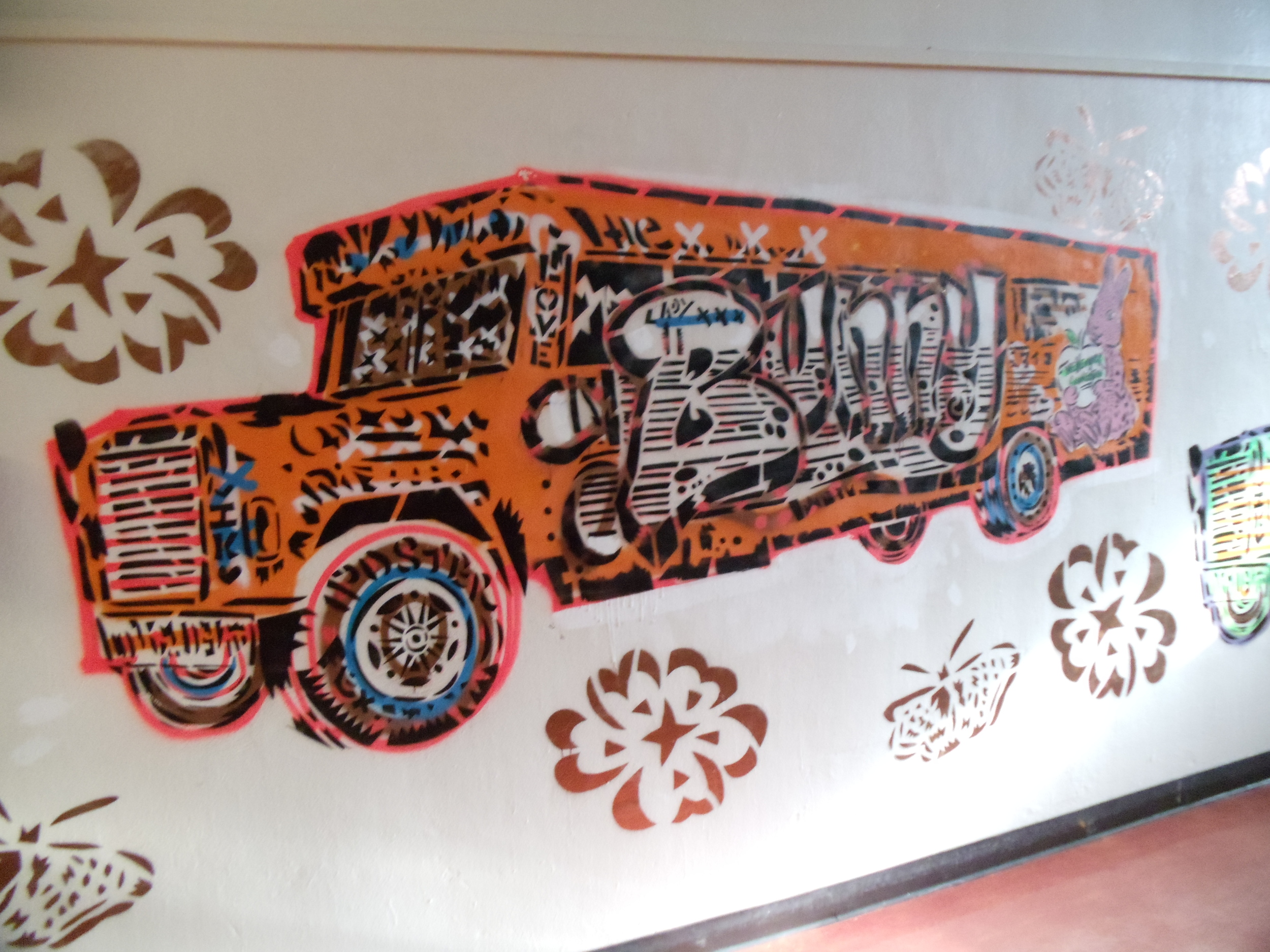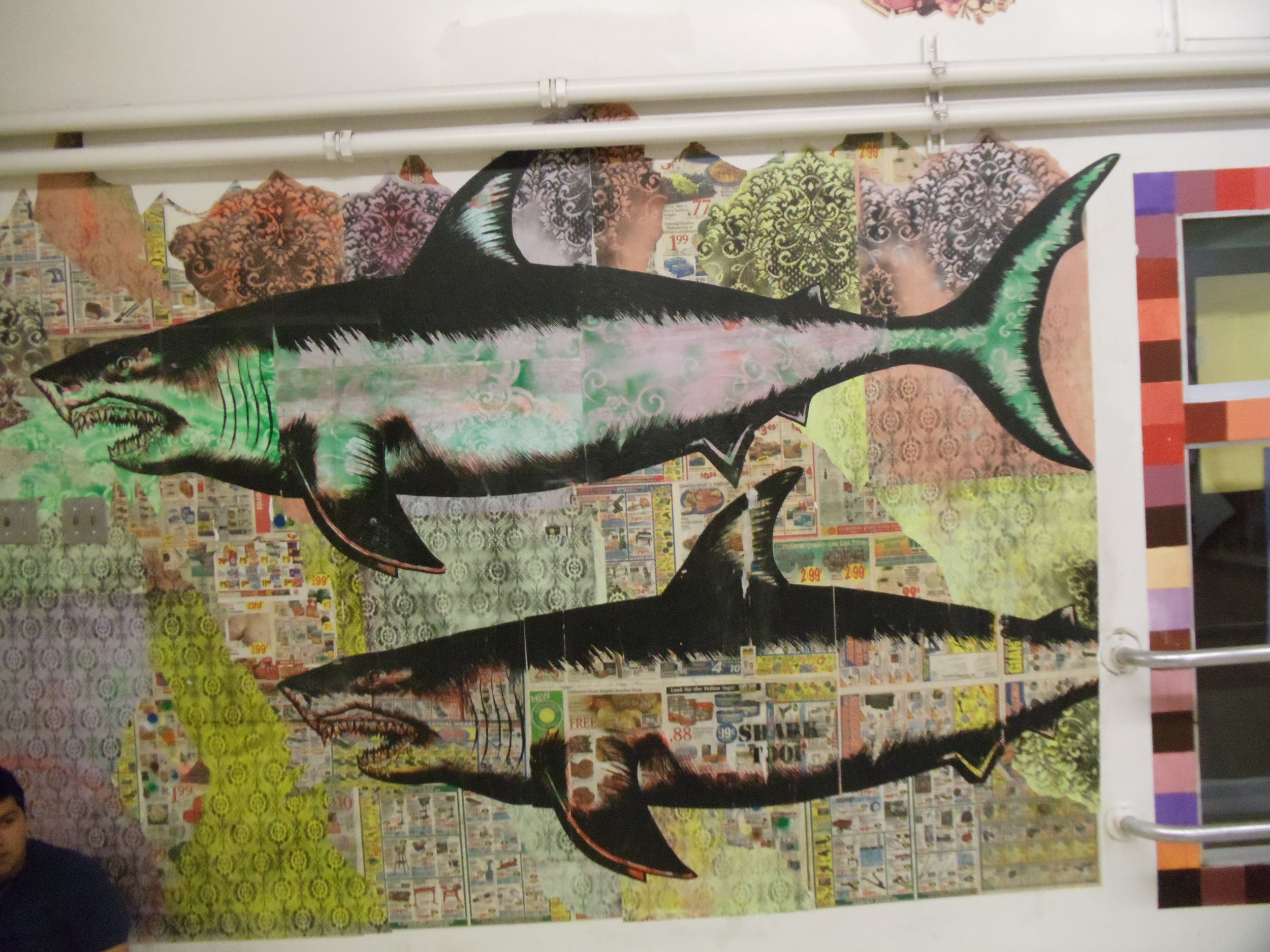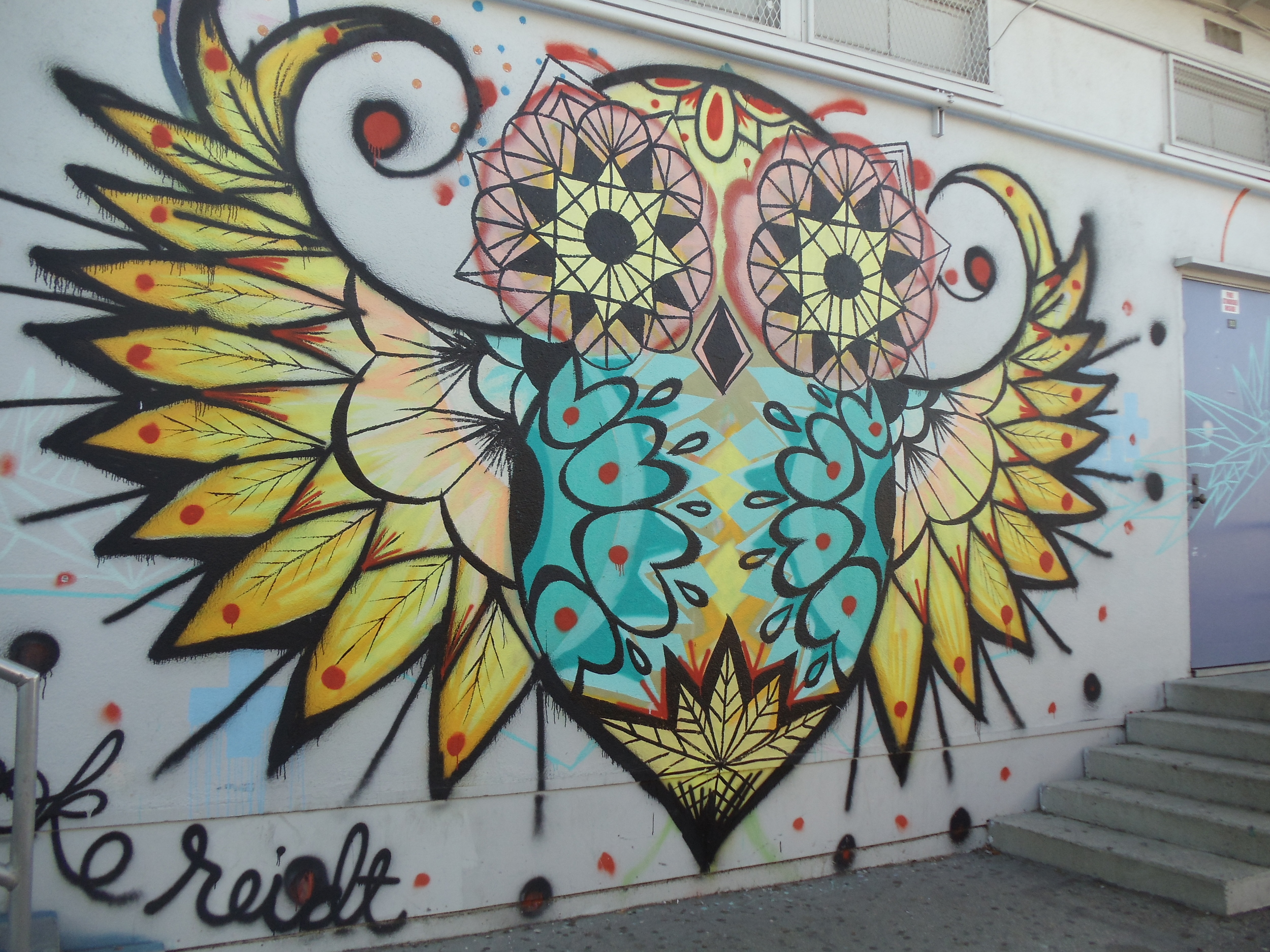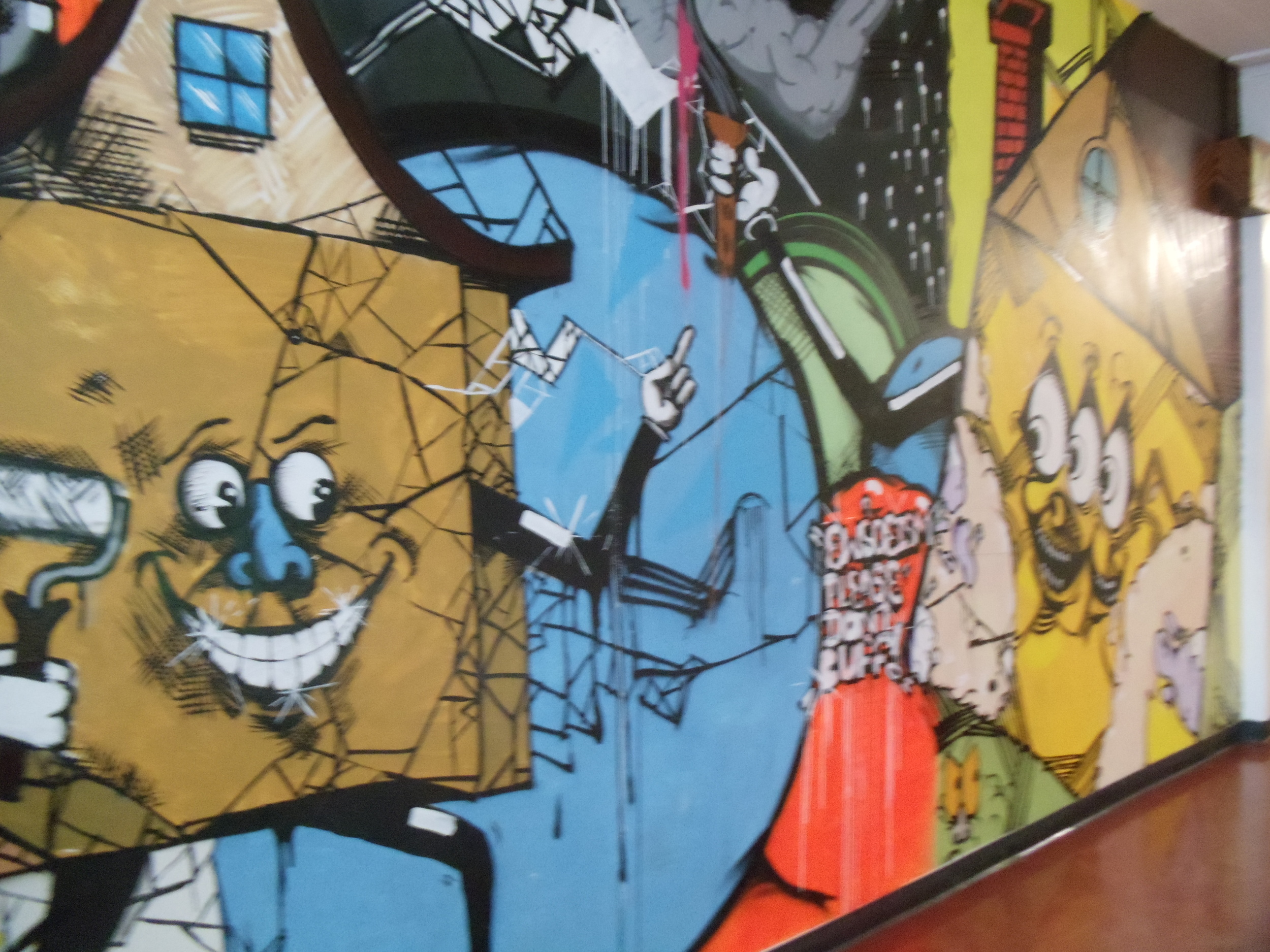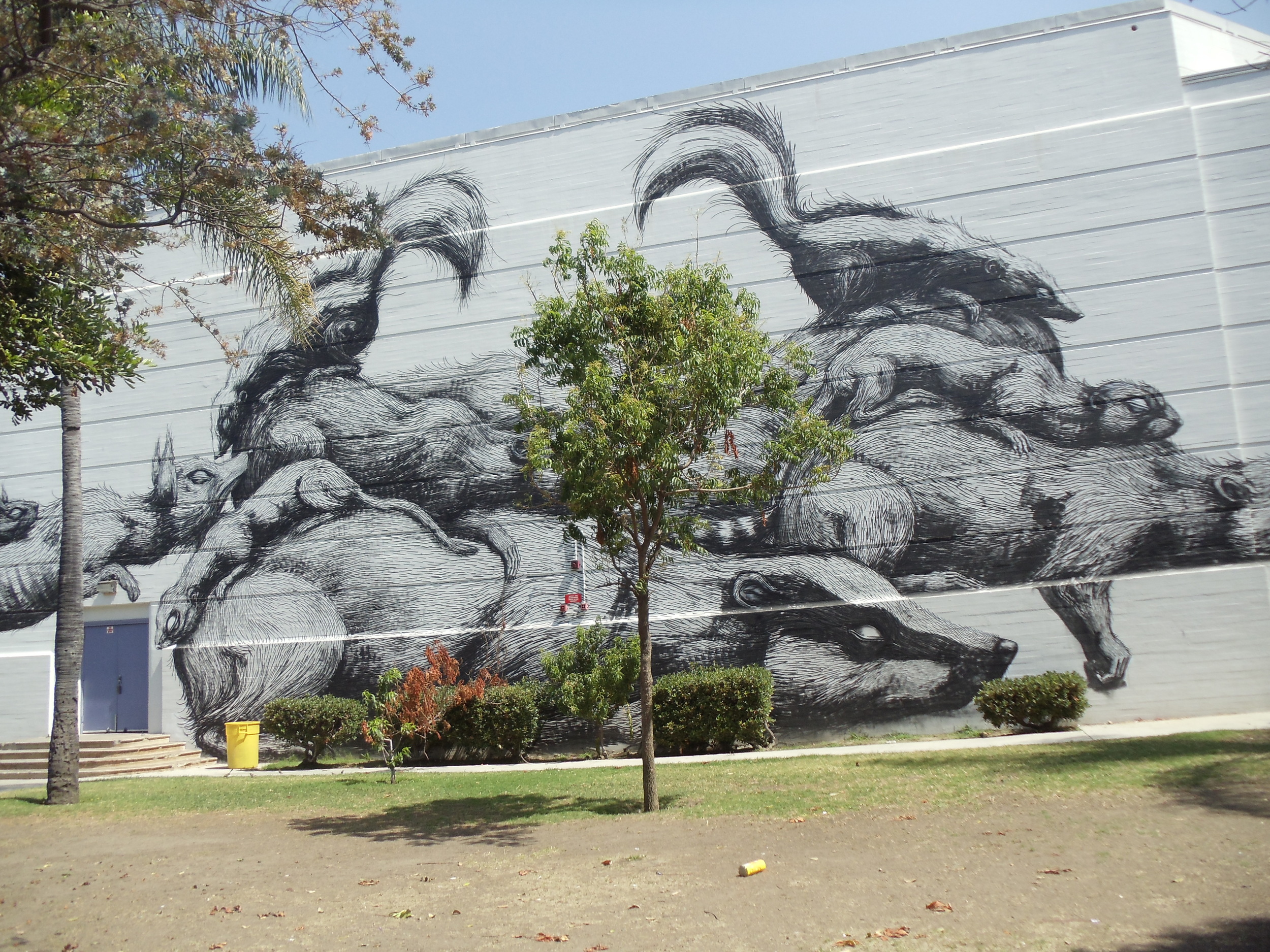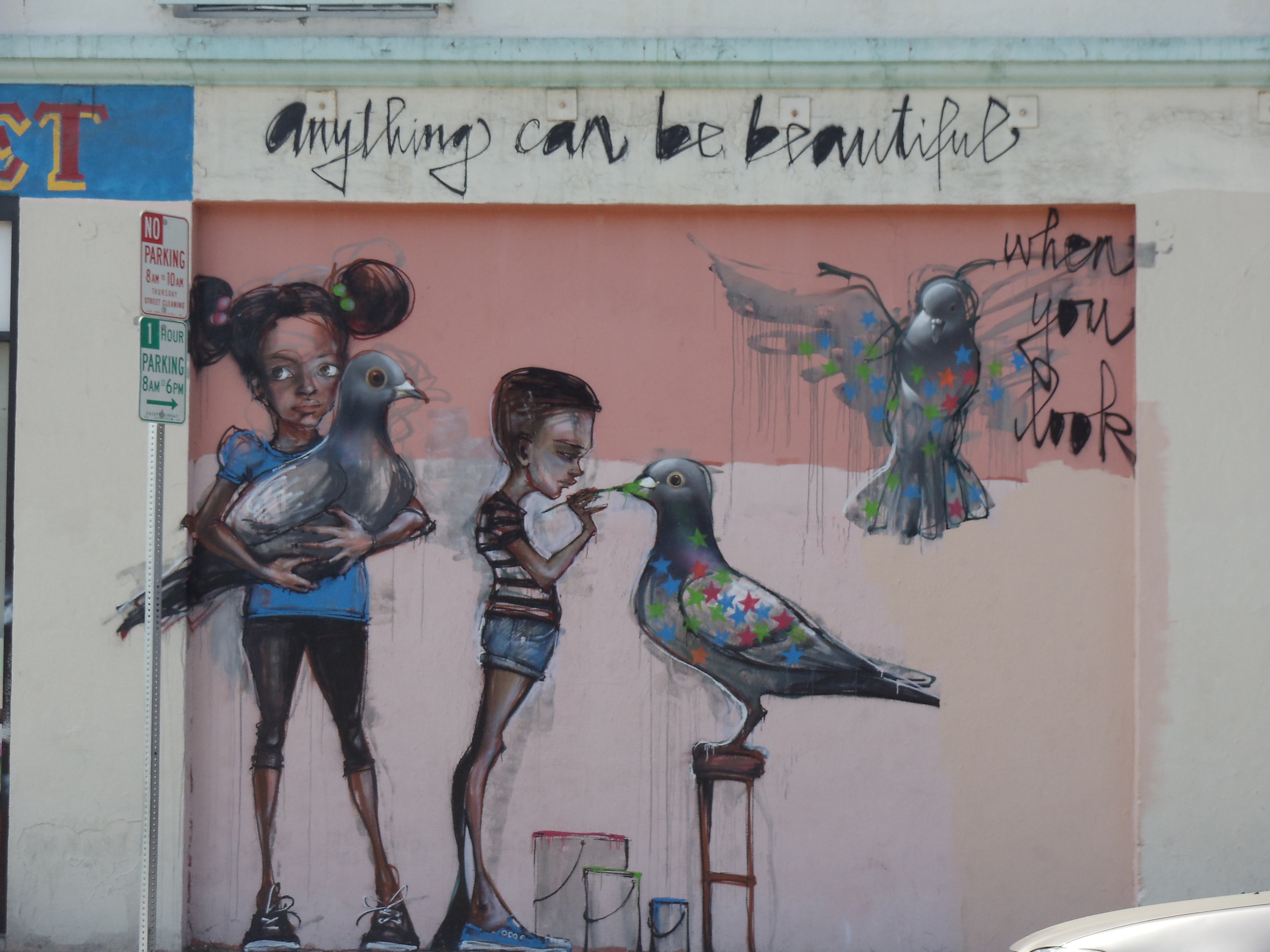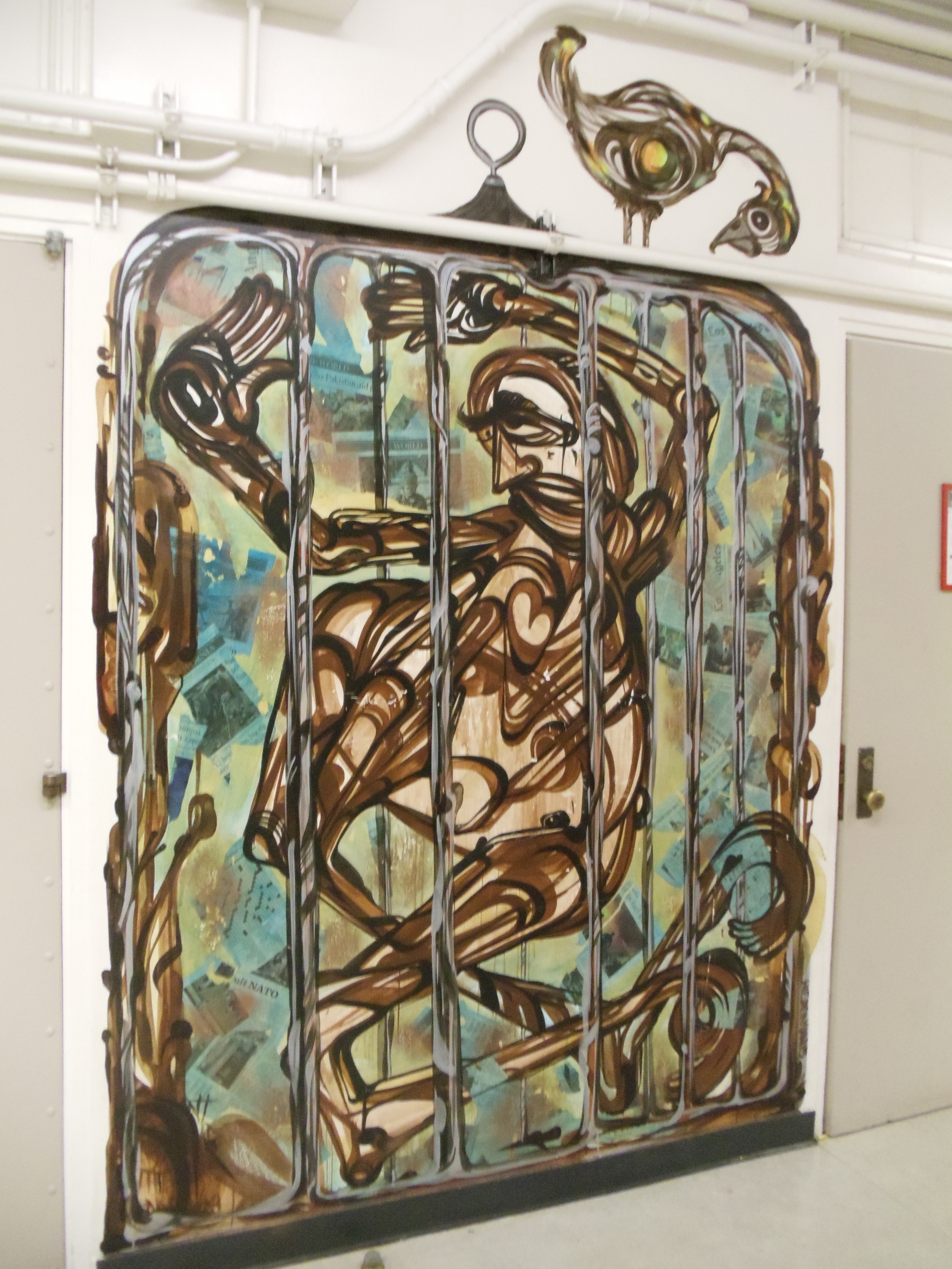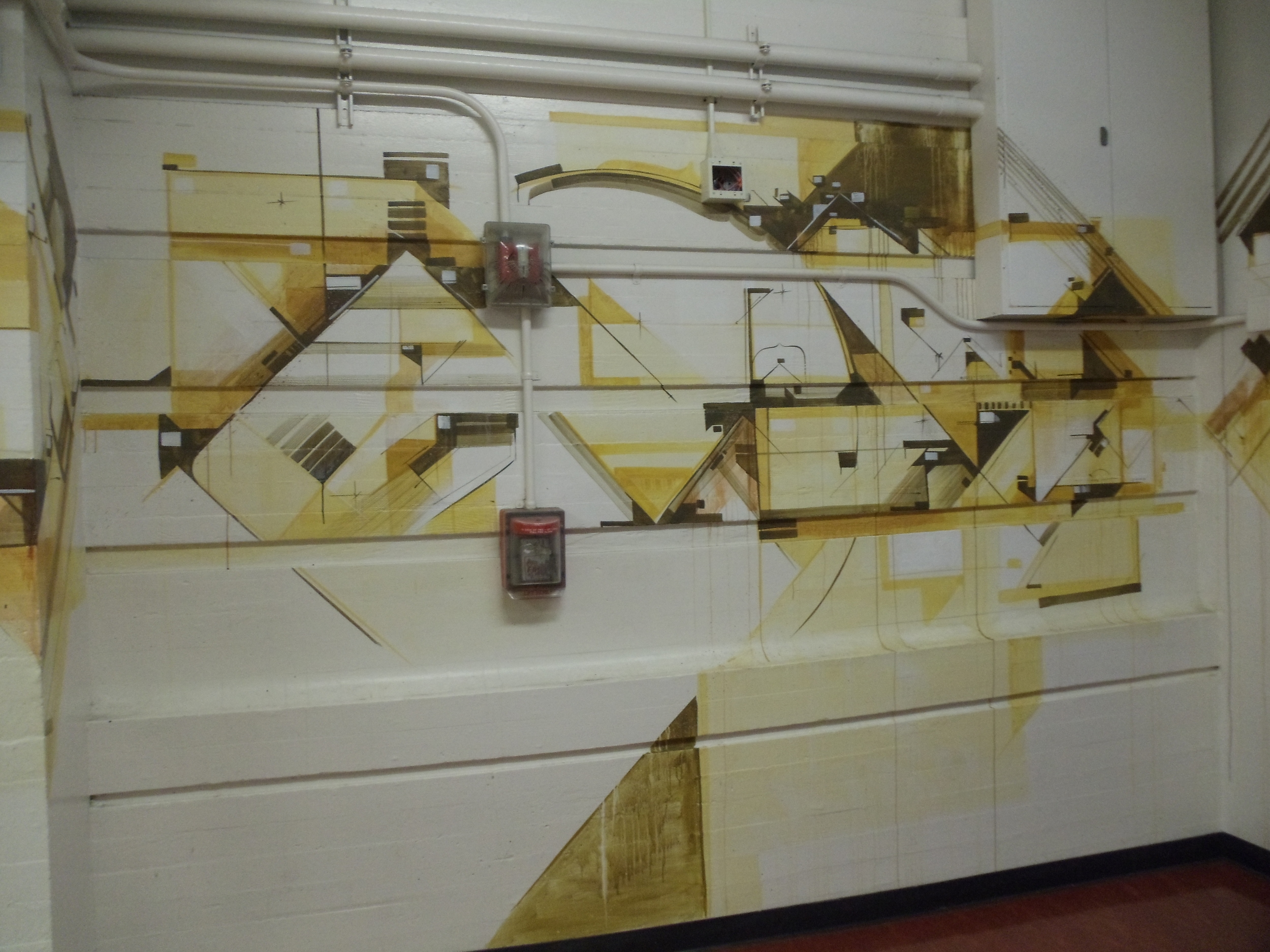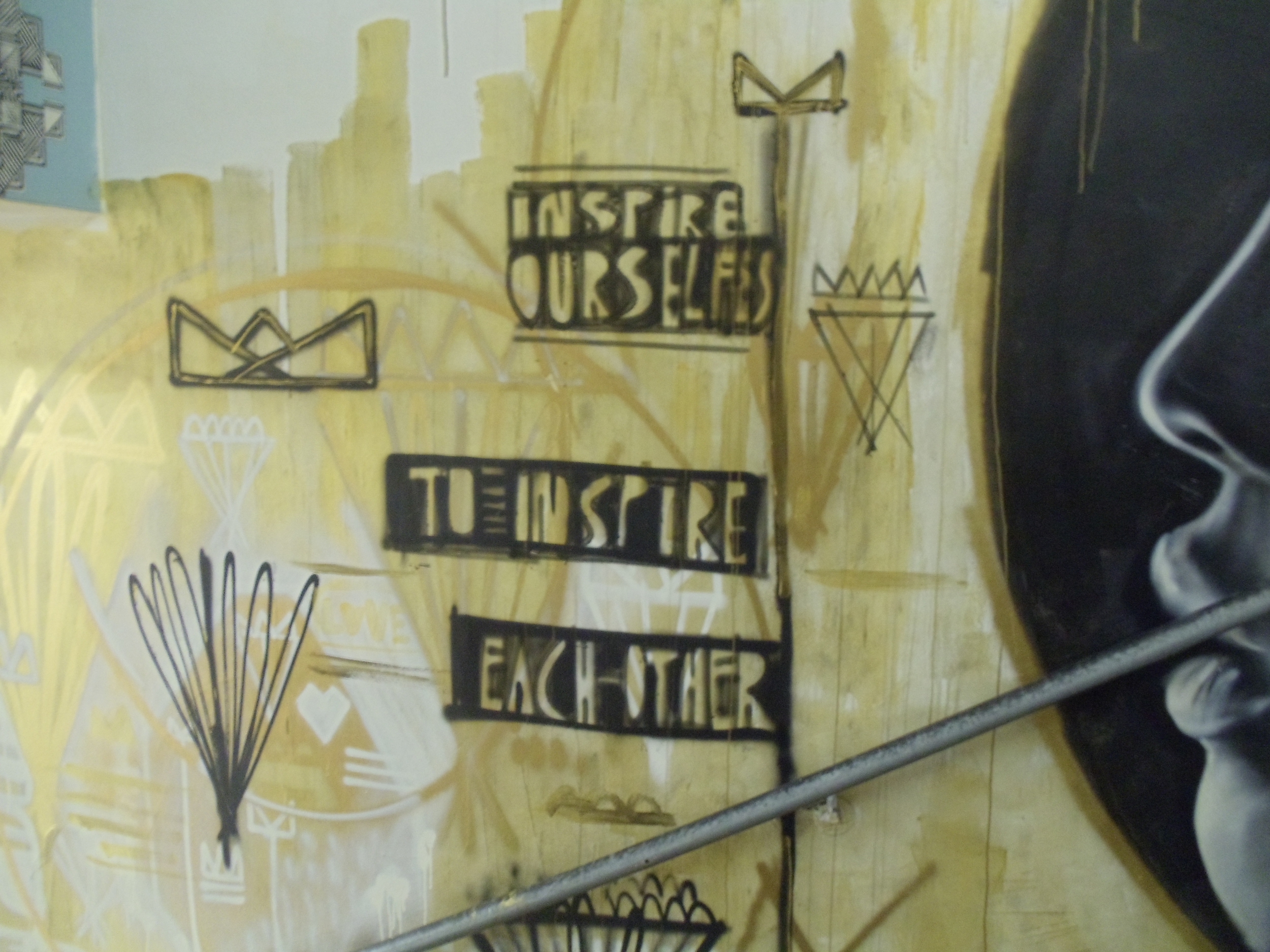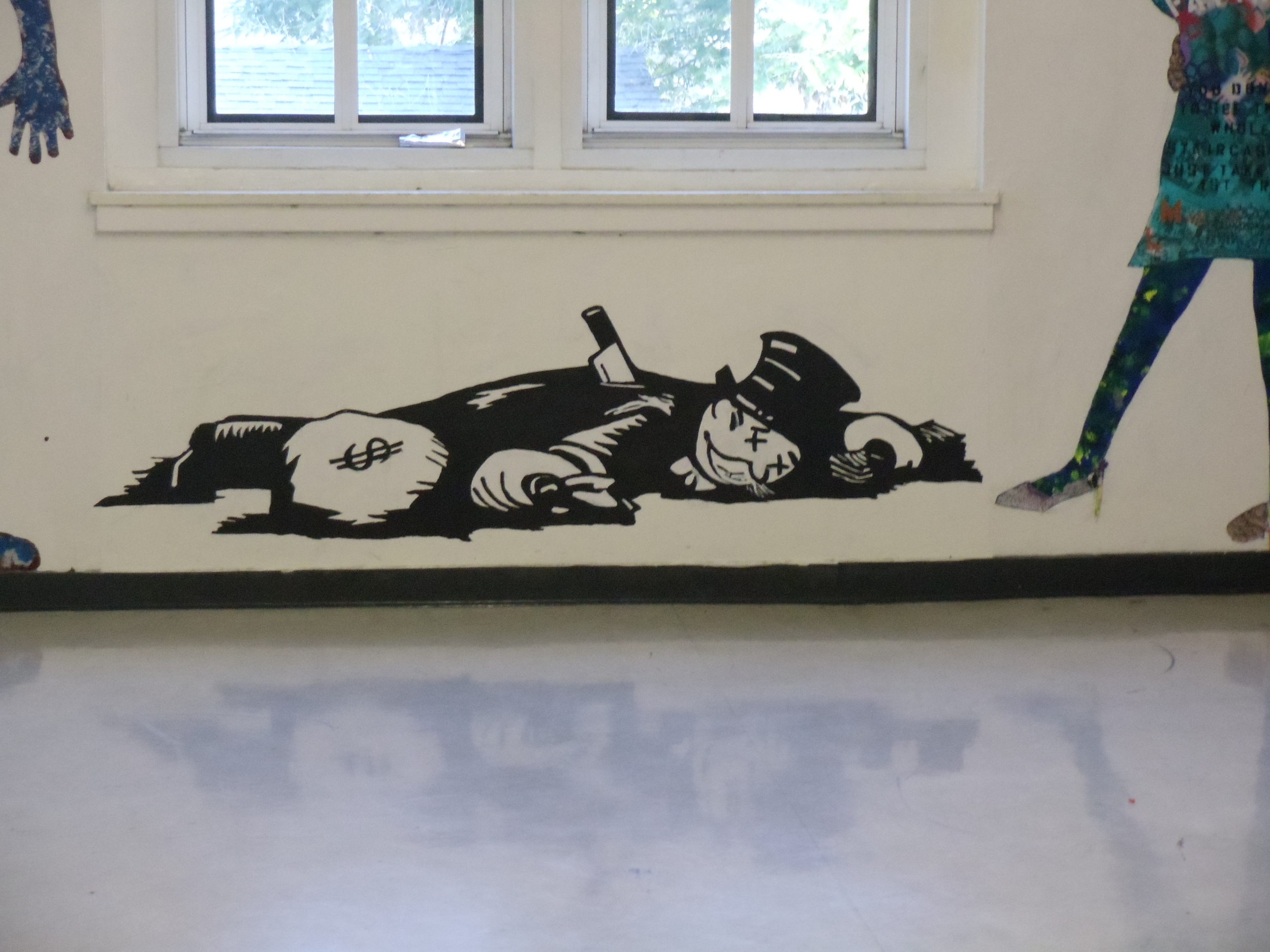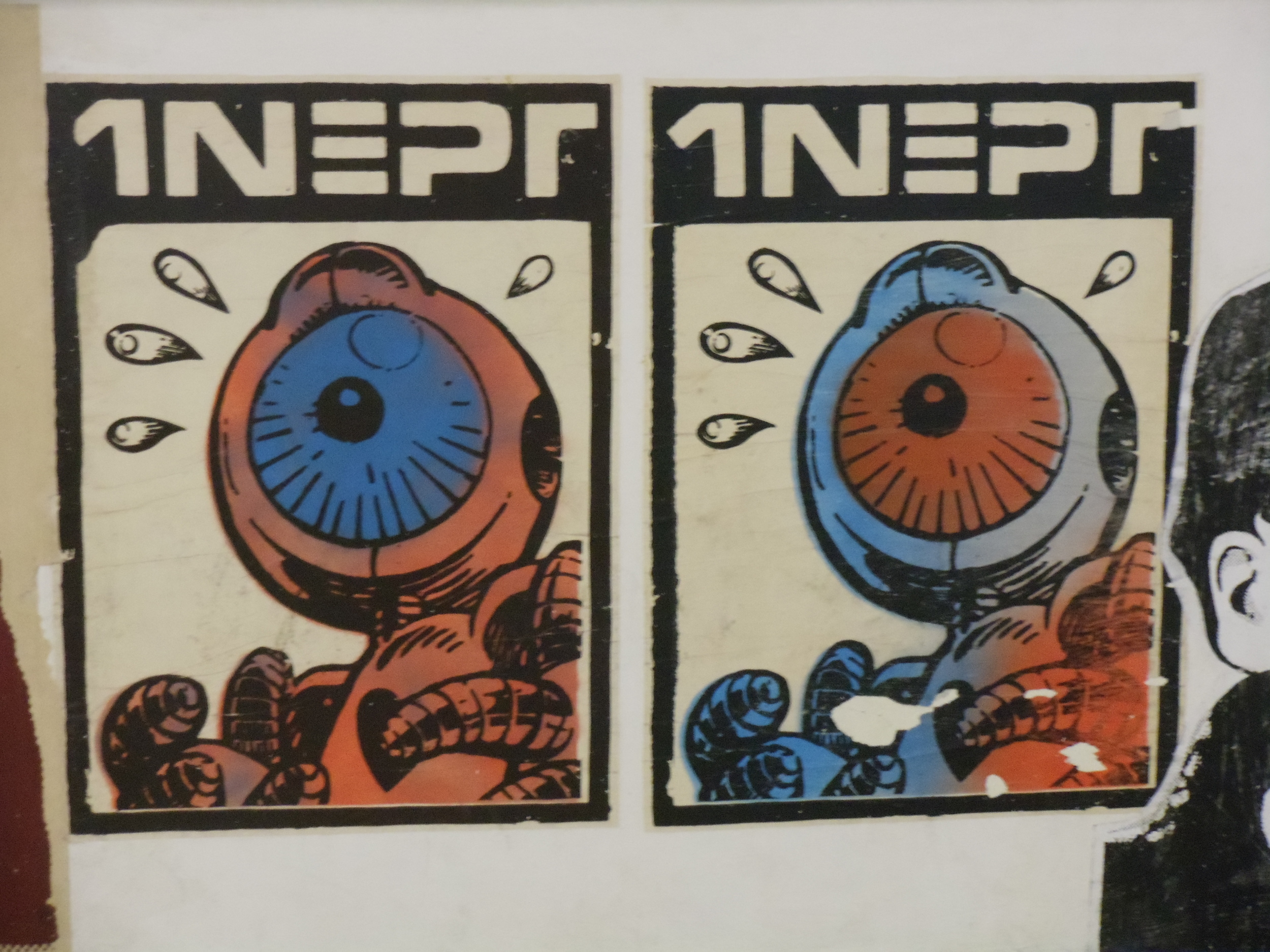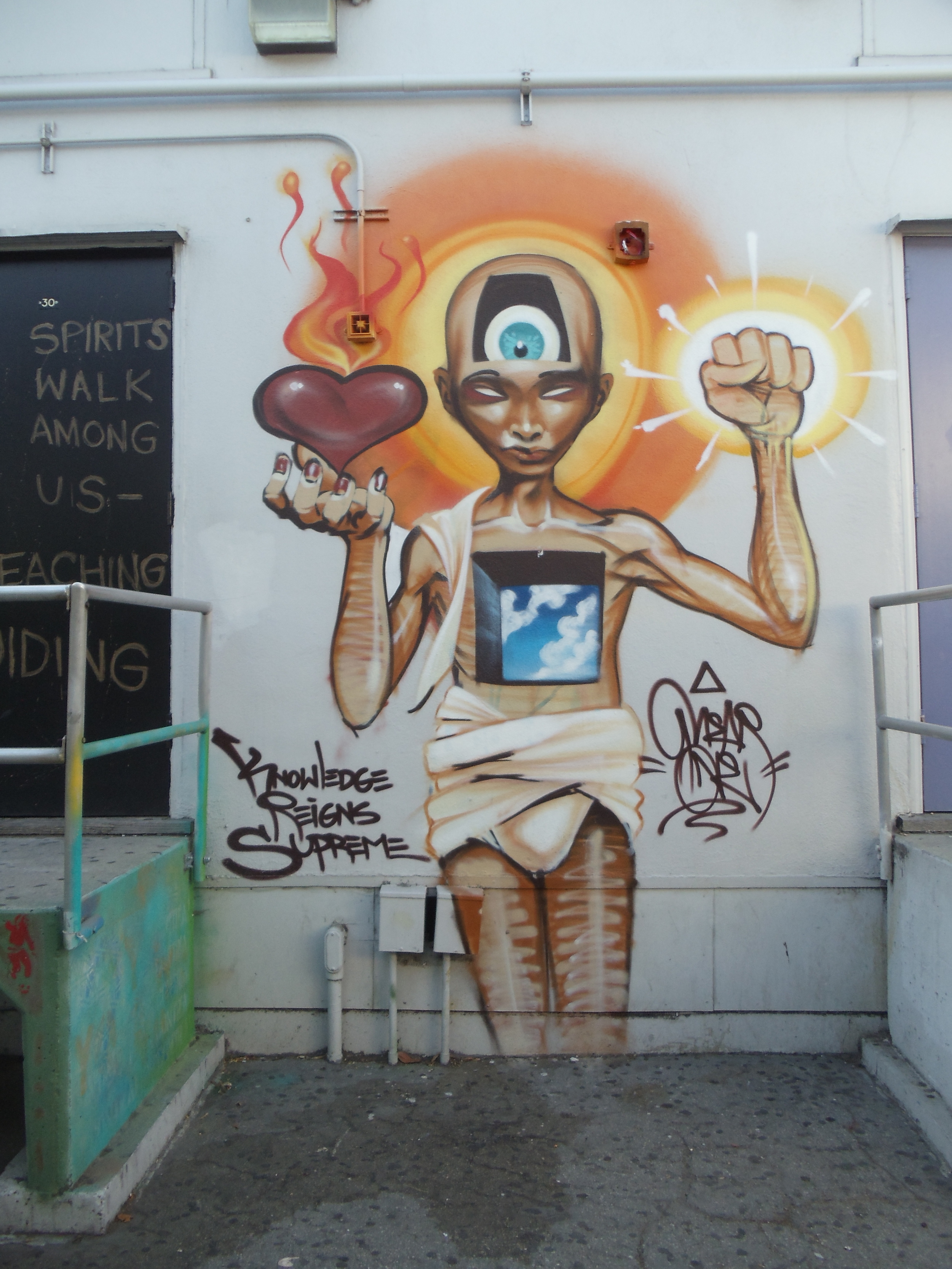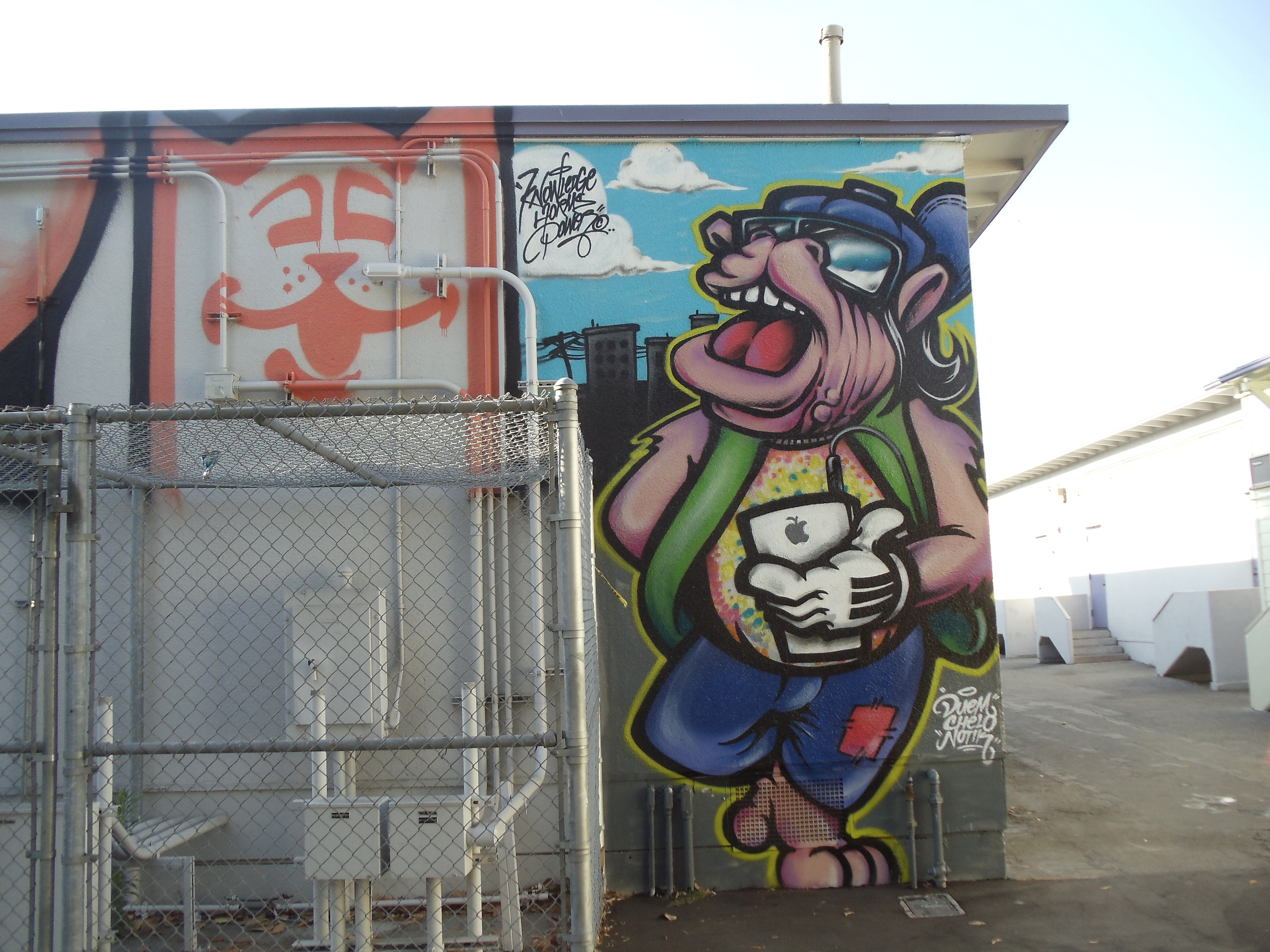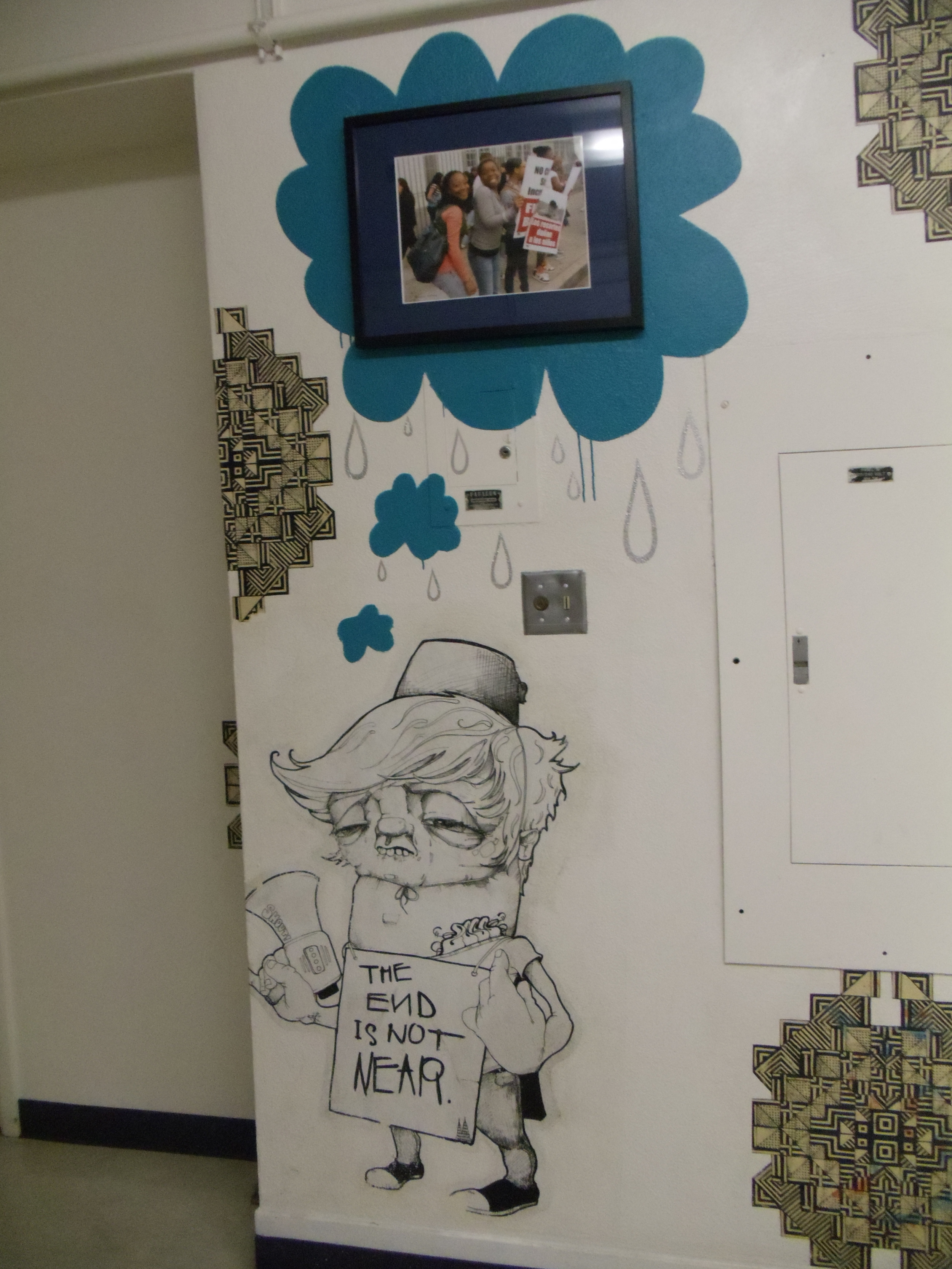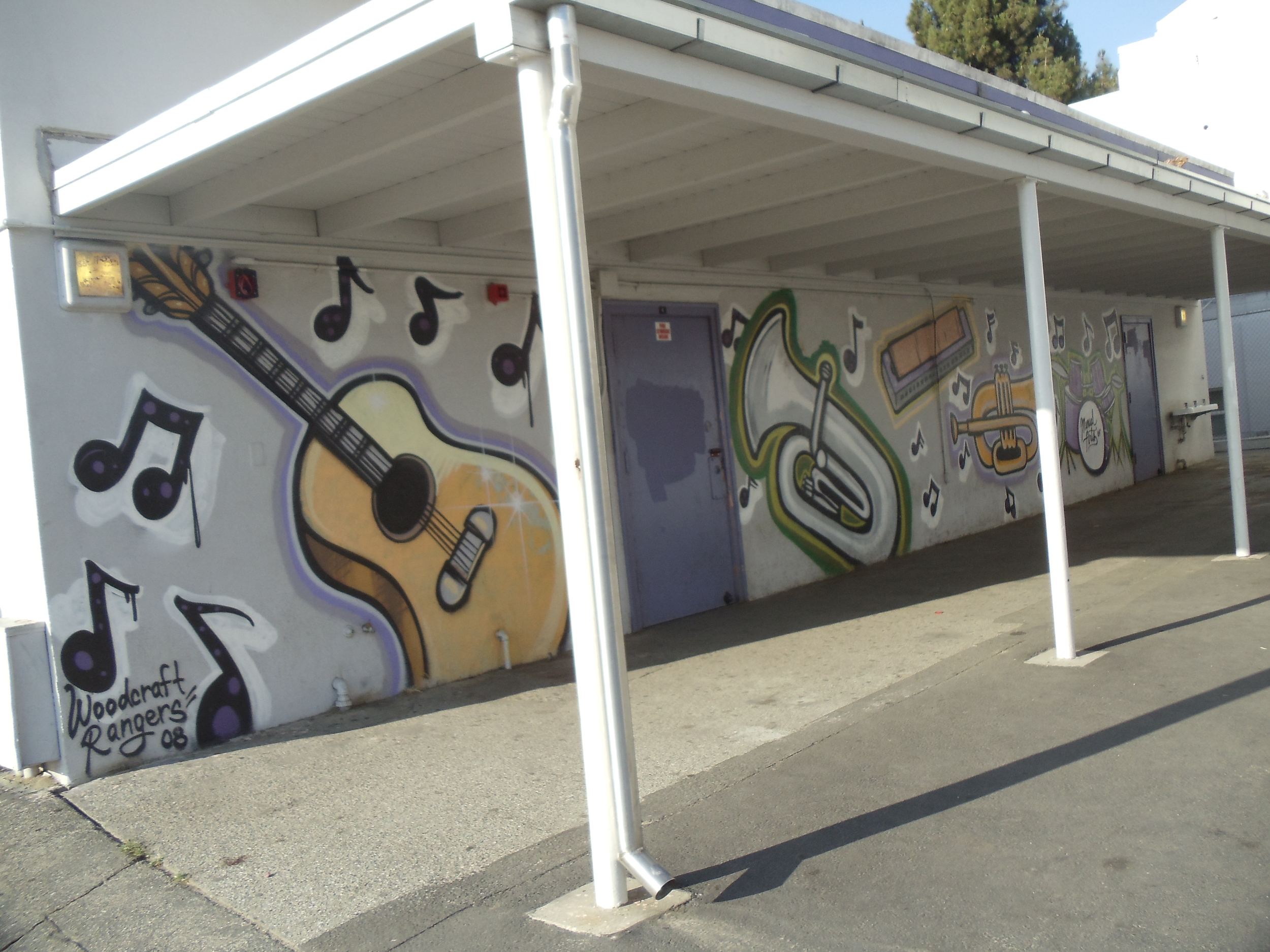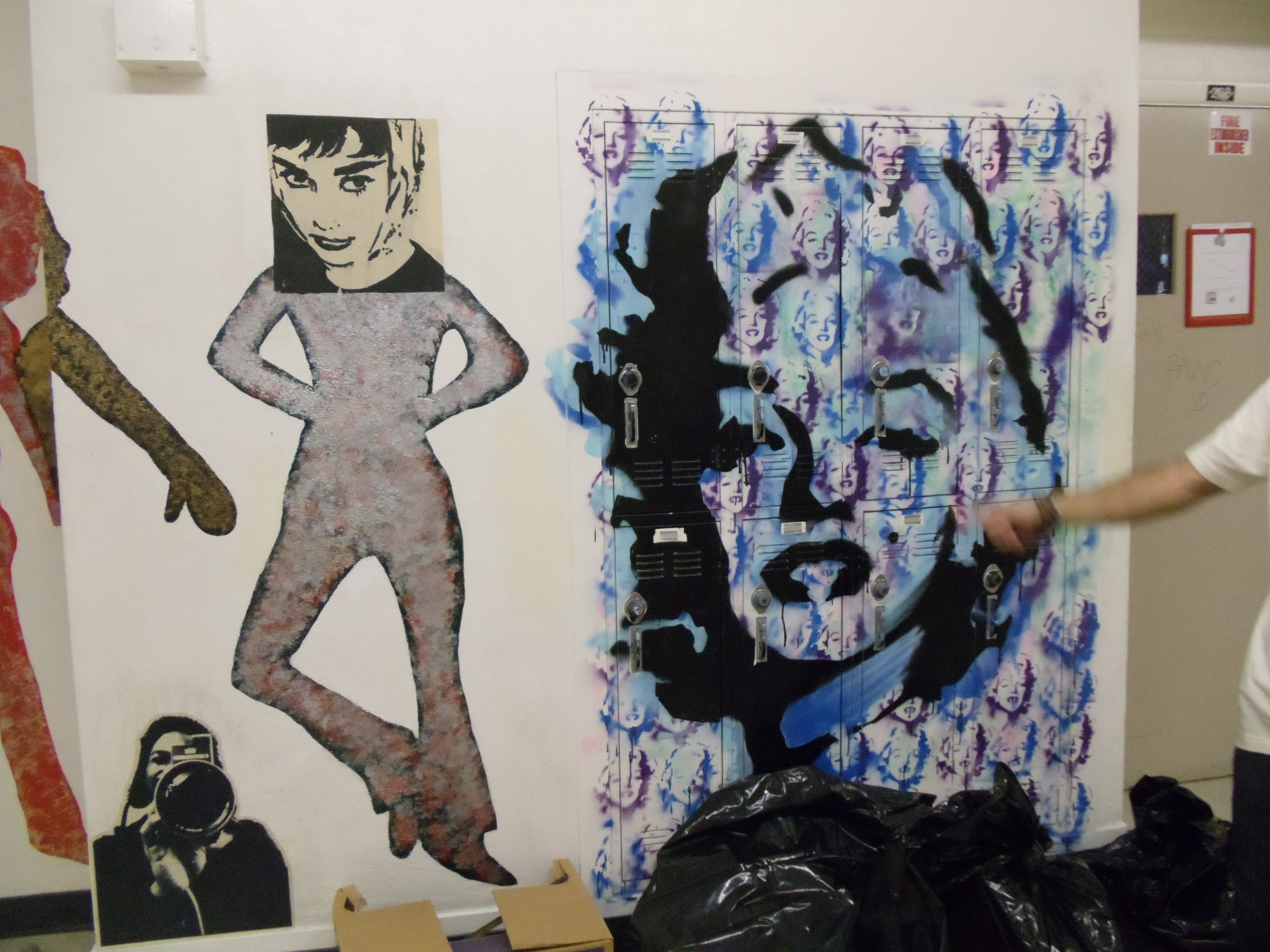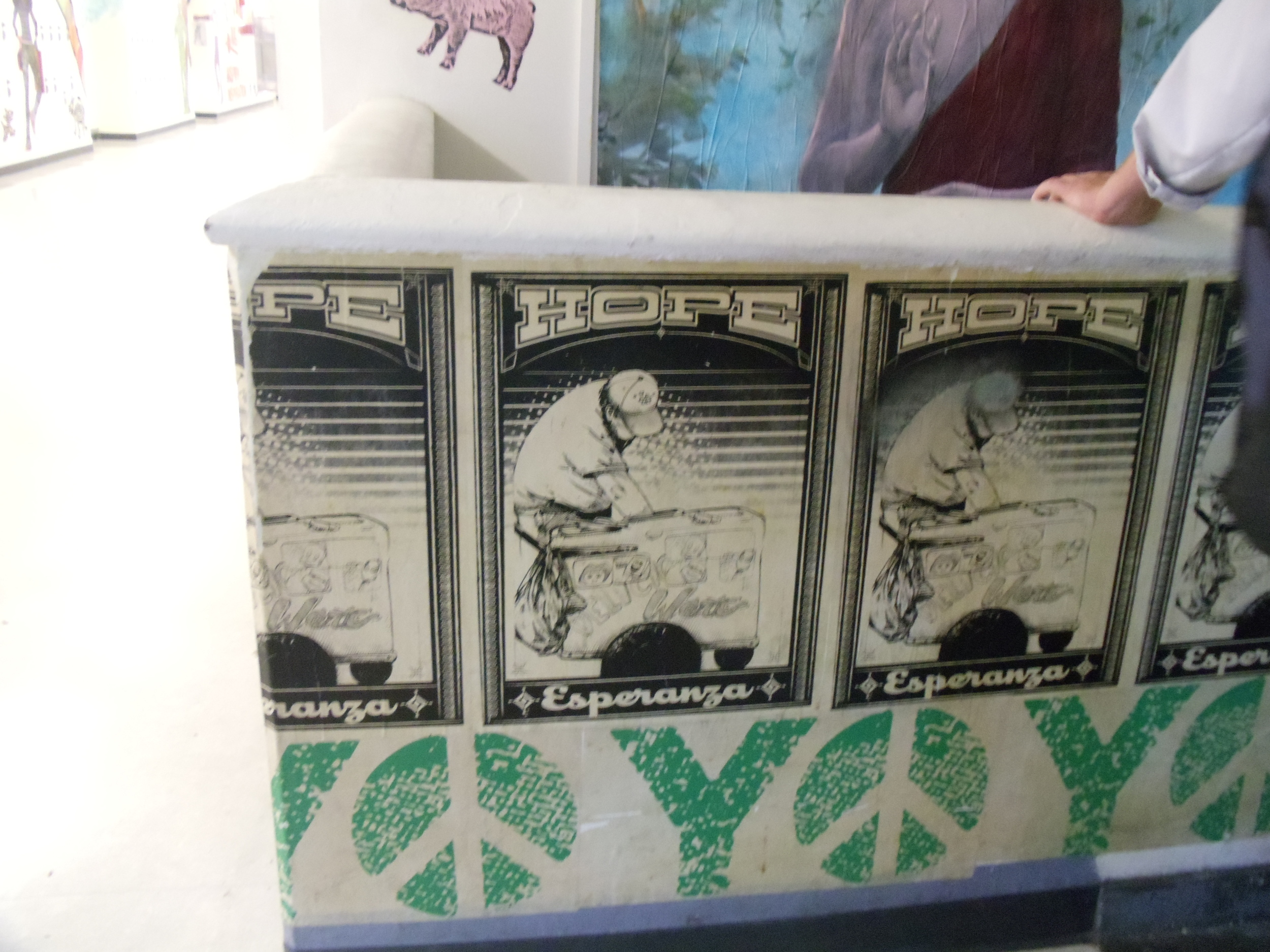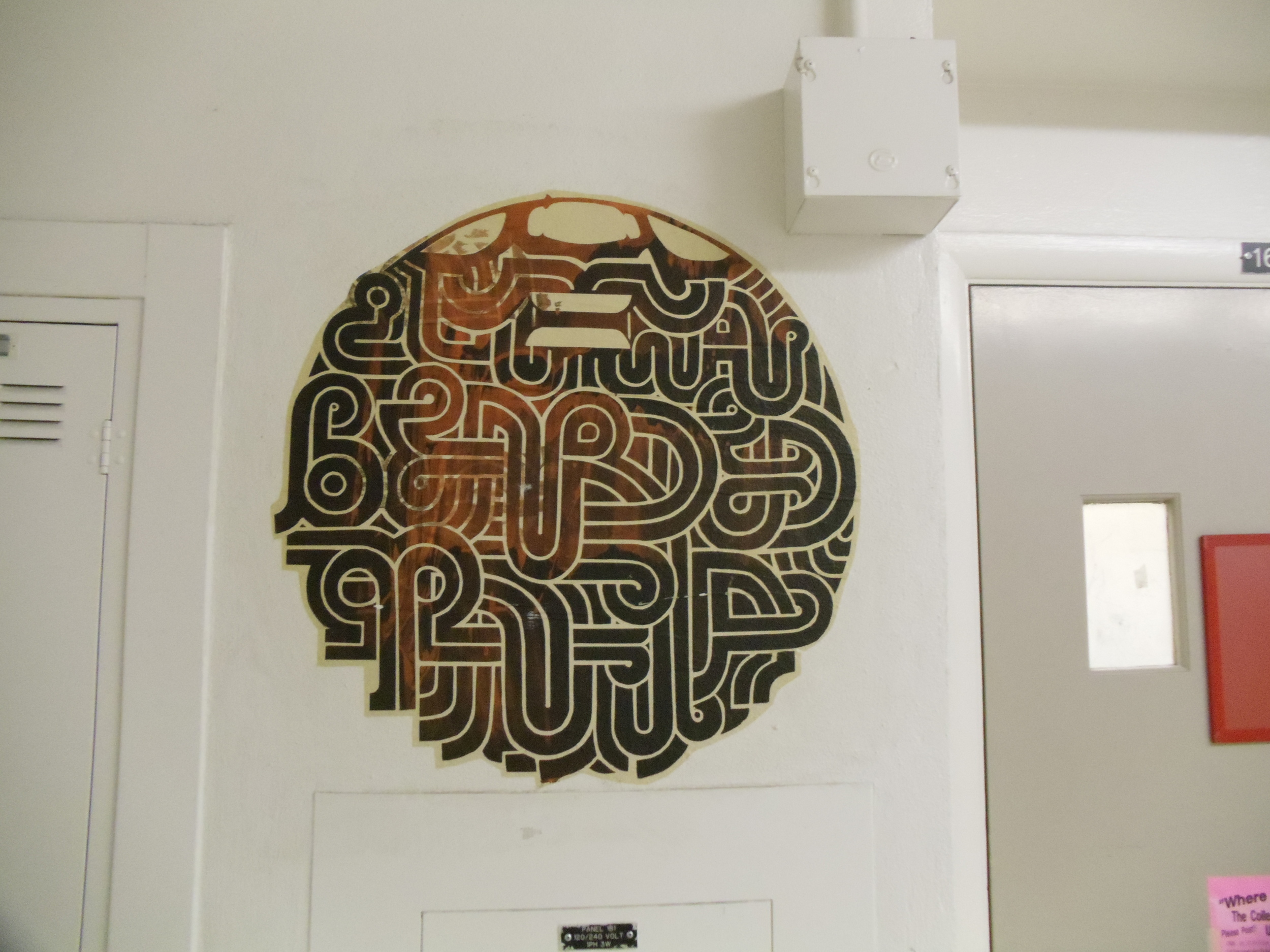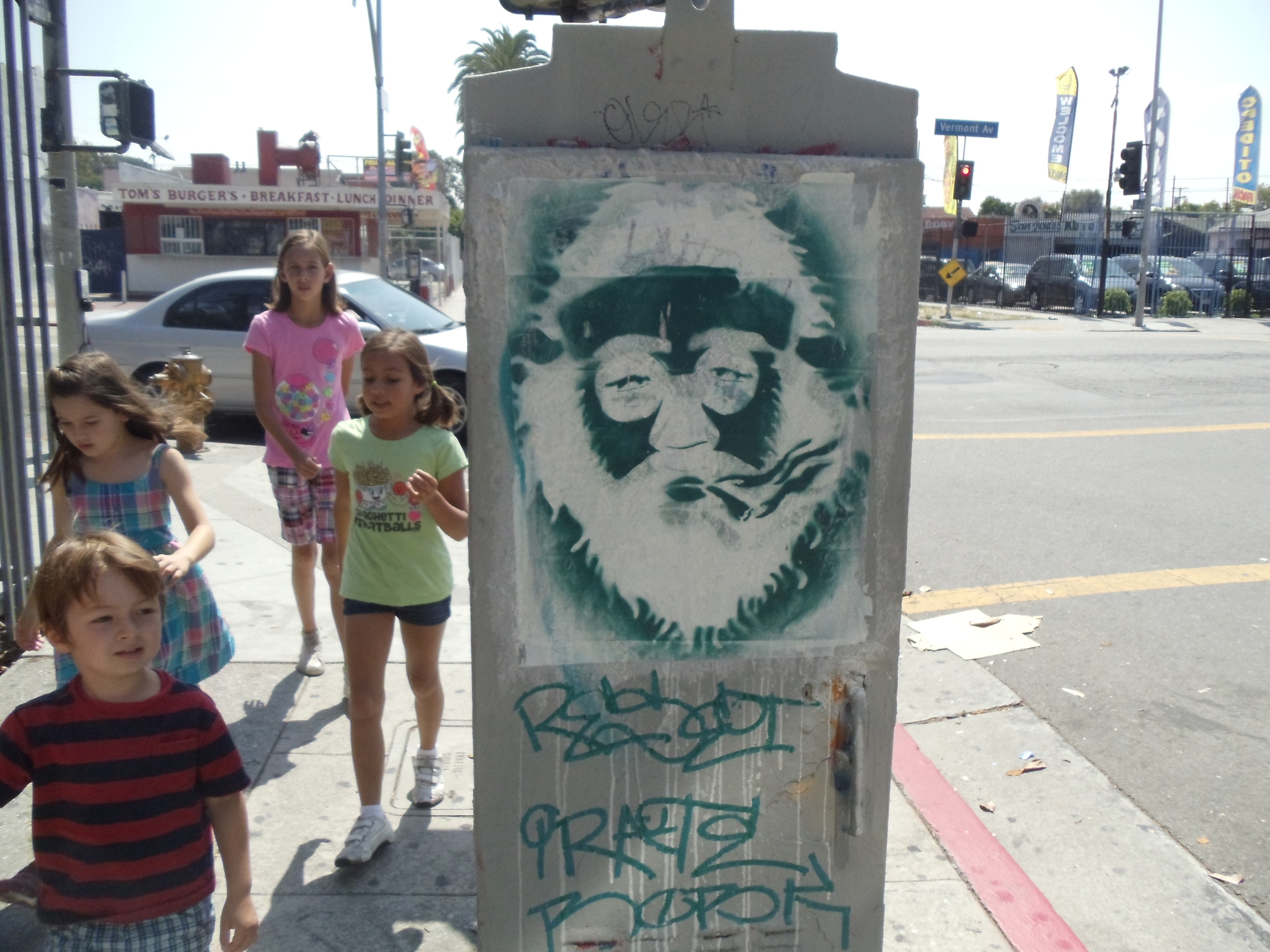
From time to time, I get a chance to sit down with some amazing people and talk about their art.
I would be remiss not to write a bit about this experience.
Murder by Death at Fingerprints
Badassness and reality
How does that voice come out of that man? A question many ask when they first hear Murder by Death frontman Adam Turla. Comparisons to Johnny Cash abound on the web, but Turla's gritty songs take on a sound a little more rock and a little less country then the Man in Black.
Singing about whiskey and reveling in the dark side of humanity, David Fountain who hails from Atlanta plays the slide guitar, bandolin, and banjo in various songs. They played mostly stuff off their new record Big Dark Love, which I picked up and had the band sign. Since the show was at 2:00 on a Sunday, I just jammed over to the Finger, walked in while they were playing the first song and left before 3:00. The only people I talked to were the band members and they were super down to earth folks.
They actually all live in different cities with Turla and Sarah Balliet whose upright bass looked like she made it and then it was dropped from the third floor, residing in Louisville and drummer Dagan Thogerson in Portland where he bar tends. Matt Armstrong who played bass at the Wayfarer (formerly Detroit Bar) that evening shopped for records at the show for Fingerprints (too much loud).
Funny, I had heard of this band, but never checked them out. When I say them on Spotify, every related band was one that I like: Cursive, Good Life, Two Gallants, Okkervil River, Weatherthans. I've been listening to a Murder by Death station on Pandora the last two weeks and it's pretty sweet. Dark, gritty, ominous, and deep, Murder by Death expose emotional dreariness and douse it with whiskey.
Joel Jerome and Wild Pack of Canaries at Fingerprints in Long Beach on 1/8/15
I love going to shows at Fingerprints. It’s free, close, early, and I can leave whenever I want. Joel Jerome and Wild Pack of Canaries on January 8, 2015 was all that and more. Wild Pack is a six piece featuring Rudy de Anda on vocals and guitar. If you've never been, Fingerprints is a large record store in downtown Long Beach with big open ceilings and signed framed posters from all the in-stores they've had over the years. I used to work there over 10 years ago at the Second street location and I like the new location much more.
With Matisse Ibarra on electronics, J.P. Bendzinski on guitar, and Miguel Vasquez on bass as well as London Guzman on Saxophone, they play a style of rock that blends Pink Floyd and Elliot Smith, at times straight up rock and roll at others mixing in strange electronic sounds and saxophone blasts. A female vocalist, whose name I missed, performed along with them providing some pleasant contrast with de Anda’s multi-facted lead vocals. They played 8 songs the first was a funky song with Spanish lyrics, the second was called “Brace Me”, and the third: Vazio was dedicated by an emotional Alfred Hernandez, drummer, to Long Beach’s own Ikey Owens who played keys on this song on the album Agua Amarga.
I had a difficult time taking pictures because I wanted to get some good shots, but had just acquired some new lenses because the previous one that had come with the camera was broken. I struggled taking good photos. Rand Foster, the owner of Fingerprints was nice enough to let me go on the stairs that go up to a loft area that's closed to the public and take some shots from there, but I still couldn’t get that great a shot and switched my lenses a few times trying to figure out how to be a photographer. Rand even gave me some pointers on the staircase white we watched Joel Jerome.
Joel Jerome showed up with a six piece band. He opened with a cover of T. Rex’s Cosmic Dancer. The sound filled the room. Although the event was held for the release of Jerome’s album, the Long Beach heavy crowd thinned for Jerome’s appearance. I stayed for five songs mostly, I’m assuming, from the new album. Jerome’s band sounded like a much more mature Dios (Jerome’s former band). I actually saw them up in San Pedro over ten years ago. The band featured two percussionists along with a keyboardist, a bassist, a rhythm guitar and Jerome on guitar. I'm not sure who the supporting band was. Probably the babies on acid, but they didn't look like babies as a couple of the guys had ample lamb chop sideburns (Joel Jerome and the Babies on Acid was one of Jerome’s previous monikers). Jerome seemed to dial up each song on his ipod-like device in front of him. There set was super groovy mixing a Beach Boys vibe with Jazz, 70s rock, and chill wave. I had to go sell a bike though and my phone died and I was frustrated about the whole camera thing anyway. It was super fun though. Chris Baker DJ filling in the breaks with some kind tunes. And I saw Bill who I used to work with and my friend Morgan who does the sound for all the Fingerprints shows. It was good times.
High School Art Teacher Turns Inner-City School into Street Art Museum
Mark Ayala is fire. He is a commodity, an art teacher that would be an asset to any school community. He is an artist, but I’ve never seen his art. Sometimes he paints or draws in front of his students to demonstrate his technique or even brings in his own pieces of fine art, but his greatest attributes are his connections within the art community and his vision and forethought in curating a unique art gallery. Ayala’s contribution to the street art community is his creation of “a time capsule for street art” in Manual Arts High School in south LA. Unfortunately, he left Manual at the end of the 2011 school year because they converted from a year round school back to a traditional. This change cost 55 people their jobs including Ayala. We hooked up with Mark before the school year was out to talk street art, teaching pedagogy, school administration, and art’s connection with the community.
As I was driving towards Manual Arts High School on Vernon Avenue in the area now known as south LA, I was mindful of the condition of the neighborhood because I wanted to fully appreciate the difficulty of Ayala’s project. On Inept’s website, whose work I would see later, he shared an incident when he was turned away at the school because they were under lock-down. A non-student gang member came on campus with a gun because a student came to school with a large amount of marijuana to sell and the local gang doesn’t like this type of competition. The demographic of the school is largely Hispanic and does not include a single Caucasian student. As I researched test scores, I learned that 1 percent of the students were deemed proficient in Math and English. Mark Ayala, an art teacher at Manual Arts for the last four years, faces these and other obstacles as he attempts to educate students about street art, fine art, and ultimately, life in general. Ayala, who gives docent tours at the school as if it were a museum, has curated over a hundred street art murals and uses them to motivate and educate in an innovative way.
Imagine teaching students about an artist or a style of graffiti and then being able to show them a piece by that artist or in that style at your own school. Ayala brings varied artists such as Chaz Bojorquez, an old school artist from The Avenues gang, Mister Cartoon, Retina, Smog City, Jeff Koons, Freddy Sam, Zoza, and Bearded Mafia to allow students to meet icons with cultural backgrounds that students can relate to. Ayala still must convince some students and most staff that this movement is a viable art form, but the connection to the demographic of his school is unmistakable. “That’s why this project matters even more because it’s an expression of their innovation culturally, and the history of its origins. We have the ability to teach assignments about that cultural history and show them that this is an expression of the only art form ever created by young people in the history of art especially by their ethnicity. In a community where they are badgered by negative stereotypes about who they are and where they are from, they lack knowledge of personal history.”
Ayala took 120 students to the “Art in the Streets” exhibit and a contributor to the exhibit also gave them a tour of the downtown district. Ayala gave out free passes and bus schedules to his student so that they could see the exhibit with their parents. This helps him convince students that this art form, something they see everyday in their community, can garner attention and evoke interest on a main-stream level. Once they buy into it, Ayala teaches students to think critically rather then just feel. He connects current events to the art and taps into what they are learning in other classes to provide a thought provoking cross-curricular program. “This is the only kind of art that our students come into the class already having a background in, moreso then the faculty even. Even the students need some convincing that graffiti is art. They don’t know anything about hip-hop culture and that it was a non-violent conflict resolution project by Afrika Bambaataa. I show them the kind of art that their people produce even though some say that it is destructive. I take them through the history from Cornbread all the way to contemporary artists from around the world. They see these artists on film, and study and replicate their work. They even meet the artists.”
Ayala tries to have the artists do their work during school hours. Typically murals just appear as if by magic, but this way the students can observe and react to the art in each stage of the process. “They see it start and get real sketchy, it looks gross, then it tapers up and gets real good.” They get stickers and the artists draw in their sketch books in the street art tradition. “I have one foot in fine art being over educated and still get a little street with it, so I can negotiate what they need.” His projects are innovative and he rarely has students not turn in assignments. Ayala shows students that as the medium gets bastardized, “That’s where it starts to get good.” That Roa piece is more like a Dutch master might do, he is into Albrecht Doerr. People think, “You can’t do that with spray paint.”
Ayala’s number one stipulation when he asks for murals to be done at the school or when advising students about putting up work in the community is that the piece has to be about building community. The neighborhood needs revitalization. The gentrification that many cities are experiencing has passed over the neighborhood of Manual Arts although it is a stone’s throw from USC and many museums. Many small shops some with Spanish names, selling toys, massages, and liquor abound in a dirty, littered urban environment. I was overwhelmed by the presence of commercial media in the neighborhood surrounding Manual Arts High School. A billboard like one that would be on the side of the freeway stands ridiculously in the front yard of an apartment building. Ayala explains his understanding of this phenomenon as we look out the classroom window to observe an advertising billboard. “In a way, street artists are responsible for the message they convey as well.” He tells students, “You can do that, but there are repercussions. I’ve been arrested and done hundreds of hours of community service, but if you are willing to take that risk, you can make a statement for free because you’re not a private corporation that can rent out a billboard.” Ayala stresses these civil issues magnifying the levity of student’s work. "You can’t put up your name or some initials. That just alienates people. This is where people get negative opinions of south LA. You can change it. You’re engaged in your community as a living, breathing space.”
The piece by Roa personifies Ayala’s ability to accomplish something positive for the school and the community through his connections with the art world. A huge piece that took five days and covers the entire gymnasium wall, the black and white mural consists of a dozen or so indigenous nocturnal rodents piled together sleeping. This piece was a collaboration with Daniel LaHoda from the LA Freewall Arts Project. Sketches were drawn and okayed by school administration. Experts from the Natural History Museum were on hand all five days of the project to insure that the animals were depicted correctly. The community response has been mostly positive, the piece is featured in a book, and Ayala paid for a two page color spread in the yearbook, but administration bothers Ayala about it because they get negative phone calls from people that perceive the work as a representation of the people of the neighborhood: a pile of dead rodents. “The reception is hot and cold right now,” said Ayala, “but they’re not dead they’re laying together playfully, tails up, and there’s not a rat in the bunch.” This is symbolic of the current administration’s disapproval of Ayala’s murals. They feel the materials are hazardous to the students’ health, so Ayala is forced to get creative because he no longer has permission to commission murals on campus.
When Herakut + Case, a guy-girl graffiti combo from Germany, came to do a piece at a liquor store, it was a media frenzy just outside the fence of Manual Arts. Ayala was contacted by the liquor store to have a piece done and he thought it was a great opportunity to continue to beautify the community without needing the school’s approval. This piece, like others around the community, take up space so that local taggers don’t vandalize the walls. When we visited, the piece had been up for four months and had only had part of its message written over by taggers. “This work is so ephemeral anyway.”
Ayala explained how repetitive tagging that seems clearly vandalism to most can be considered art. He was quick to defend all forms of art. “Tagging is an art. Its sketching for an artist, ornamental calligraphy. it’s their own kind of vernacular. It’s individual. It’s regional. It’s the architecture for all graffiti, spatially and mathematically. This is the gateway for them to understand more sophisticated realms. We’re starting to see wheat paste here which we never saw before in south LA.” He tells the students that the work they do on the street should be about building community. We have places like the Salesian tracks that are for doing work that is about individuals. The murals at the school exemplify community whether it be a school bus by Aiko, an artist from Tokyo, or a piece by Koffie of geometric shapes in the school colors that students use as a backdrop for photos.
Ayala’s forethought about this and other subjects stood out as we continued to discuss the street art movement. He acknowledged the popularity of street art and we discussed the large amounts of money people are getting for their work with an aerosol spray can. That’s how Ayala hooks the students in, by showing them that the graffiti that they see every day on the street can influence them and they can learn from it.
As we began to get into technical information, Ayala expressed that his class and the murals that he has brought to the school, specifically the art building, cannot be directly responsible for the small rise in test scores that the school has seen, but an increase in regular attendance does seem to come from the murals and the positive attitude that they provide for students. “Students have more pride as they walk through the halls in this building; it helps their self-esteem.” On February 20, 20 artists, from Mear One to local street gang, Kill For Pride, converged on Manual Arts and put work up all over the school, but one corridor of portables in particular was transformed and now lifts teacher's spirits as they enter and exit campus.
As we walked the halls, Ayala narrated the pieces that we came across. Ayala was proud of the way he mixed three generations into one piece that featured a drawing by an art teacher at the school of a silkscreen that was done by a local crew called Hit + Run, along with a piece by Gingivitis, a female student of Ayala’s. Whether it was another Koffie piece, a geometric abstract piece painted along the gas pipes that serves as a math lesson, or a large tree that stood in the lover’s hallway next to a window where you can see a real tree outside, Ayala’s murals are well planned out. Another hallway boasts political statements, while Lorraine Villareal’s piece combines photography and student community. Since he will be losing his job, he would like to work on having art in many schools to enhance the learning environment.
The way Ayala laid out each piece has significance, and he has aspirations of kitty cats at elementary schools and sharks by Sharktoof in science buildings in many other schools. His own students used a clip art school bus emblazoned with a Spanish quote. Spanish teachers love this because they can use it as part of their lesson. “You can use it like that,” one of Ayala’s favorite phrases. The gangsters use to come and tag their gang signs and during passing period they stand next to it and rep their gang. Now, students have a sense of pride especially in the art building. Ayala even considers the Adult school that takes over the campus at night with wheat paste pieces such as one emblazoned “Esperanza”. Ewsoeism did a piece with a class that was taught on campus which captures the downfall of the housing market with houses literally running away.
Ayala understands what we are up against. Teachers and positive street artists. As we passed another outdoor hallway that was spray painted with musical instruments, Ayala pointed out that they were doing this already, Ayala’s colleague, John Lasko, installed paintings of silhouettes of people similar to an old ipod campaign, so he convinced administration to let him do street art murals. Storage sheds painted with Manual Arts High School emblems looked like pieces of art rather then eyesores, but Ayala worries about the Roa piece and the graffiti style pieces. “What happens when someone comes and paints over all this?” “Who’s going to rise up? What’s that going to be about?” Ayala asked rhetorically. Ayala’s impact on both education and street art is already prolific. He will surely continue to provide positive viable ways to assist underprivileged communities, but the fate of Manual Arts remains unclear.
Nathan Cartwright: Mad Scientist, Samurai, Shamen
Nathan Cartwright met us on the sidewalk outside his building in the middle of the art district in downtown Los Angeles. As we chatted, he greeted several people who walked by or rode by on bikes calling them by name. It seemed strange with the huge buildings towering over us, but I became cognizant of his congenial nature from the beginning of the interview. Inside the building that holds the Hive Gallery in the basement, we met a few of the tenants on our way to the elevator. All of the occupants are artists. The walls of the large lobby are affixed with paintings and tidy fake potted trees align the walls. We went up the elevator, down the hall, and entered Cartwright’s apartment.
The interview started abruptly because I was immediately drawn to several pieces that he had on the wall and was compelled to start asking him questions about his work. On a few of his pieces, I noticed small figures with yellow smiley face masks on their faces. Cartwright says, “I’m all about the mask.” He uses the smiley face to satirize the emoticons used in email and texting which don’t really carry any emotion. When “The Man,” as Cartwright calls him, wears the mask, then he becomes drone-like fulfilling his tasks brainlessly. In one piece, a farmer has his mask partially coming off; he has begun to understand real meaning. When the mask is completely off, that is “The awakening.” In typical Cartwright fashion, the back story, the mythology within the painting, far exceeded my interpretation.
This type of understanding of Cartwright’s works is not necessary to enjoy it, but only adds to the complexity and interest of the piece. Cartwright feels the viewer has to first ask: “What is their experience? Are they repulsed by it or intrigued by it?” That should be the main factor in appreciating all art, but if they want to study more about it or learn what the artist intended that just adds to the experience. Cartwright studies Eastern and Western religions, but is more interested in Western alchemy along with the Eastern religions. He commonly represents the Buddhism idea of samsara, “life is filled with pain and pleasure” in his work. “I’m into everything,” he explains.
Cartwright grew up in Ohio and attended Miami University in Ohio where he was influenced by his teachers in art school. One taught him to open up his process and he in turn “started getting really messy, almost like Mirot.” Another teacher, Mrs. Kang, told him that drawing could be anything these days, giving him further license to experiment with his technique. After graduating, he traveled to Los Angeles with an idea for an art project in mind, complete with an entire world of metaphorical characters. Eventually, he parlayed that idea into the seven lands of Hive Land.
For a recent book that he is putting together, the artists created avatars for themselves. They chose which land they should live in based on the characteristics of the lands that Cartwright supplied them with and then they created their avatar based on that. “It’s a way to commemorate my featured artists, but also get them mythologically involved in a theme.” They are going to play a game with the characters. There will be six tables representing six different lands, and each land will include a different challenge. For example, ethos land will have an abstract concept idea for its challenge while Mellodara will be a sculptural challenge. This is a small example of Cartwright’s ingenuity at work. They just put out their third deck of Tarot cards. They did a show with twenty-two of the major artists who all had to do research on their card. “They really get into it and they really nail it. It gets you thinking.” Cartwright continually pushes his own artists to create work with depth.
As we looked through sketch books filled with notes from books as well as research as varied as different types of yoga to invented instructions for dungeons and dragons, Cartwright pointed out more of his philosophical ideas that he brings to his work. He had a small sketch of a lake with a reflection in it. “You see the reflection mirrored off the water. That is the self, but the self is everything beneath the water too.” This mythology of the self, based in Eastern philosophy, pervades Cartwright’s work, but his abundant amount of notes and sketches indicate his attempts to represent these ideals in concrete metaphorical ways.
Another of his techniques utilized within his sketch books is straight-ahead drawings. “I’ll throw down ballpoint lines. No erasing. I’m open. I don’t know what I’m doing. It’s about connecting with the infinite.” Some of these works in black and white become intricately detailed pieces that exhibit his complexity of thinking along with mastery of his craft. He uses this idea of straight-ahead to analogize the difference between painting and illustration. “When I’m sculpting, I have a plan. Illustration is like that, where you have a blue print and you carry it out. There is no unknown there. It’s all perfection, idea, goal-orientation and goal completion. It’s very mathematical. Painting is a more organic, shamanistic process. You have to be open; it’s a risk and it makes you feel more in it. We are in the infinite only in the moment. Molecules fall into nothingness, rise back up, become something for a while. Everything is molecules. It’s infinite, just a dust bowl weaving between the known or external world and the unknown or internal world. The shaman was the channel for mythology that gave the culture meaning. Artists use symbols to create a dialogue between spiritual meaning and cultural meaning and that makes the whole thing congeal. Artists are the modern shamans of our culture.”
Cartwright’s oldest work in his archives was from his grade school years. A comic book titled “Superman versus the Monsters” where superman is attacked by bees and dragged to a hive served as a strange revelation when Cartwright recently came across it. Cartwright’s upbringing certainly shaped his current vision for his art while his thirst for greater understanding pushes him to study and explore more. He gets the balance. “A lot of buyers go for shallow stuff that’s not a risk. They want something safe that they don’t have to think about too much. It looks good and it sells. Everything I show looks good, but I’m really looking for the mad scientist, and they are very few and far between. Few people have the skill- level, intensity, and symbology along with the artistic language that has that depth. Most artists are freaking out trying to make a living.” It’s important to see the difference. “This is what sells. This is what I respect. I did four pieces for $500 a pop and another piece for $2,600. It’s fine to do both, but you have to keep pushing both sides. The mad scientist is so closed off you can’t even find him. I would just quit if I couldn’t keep pushing the boundaries. If I couldn’t be an art samurai and go to battle in my worlds and just do it, there’s no point.”
Standing in a separated area of his apartment that serves as his studio, Cartwright showed us one of his pieces from the ironic bird series. He yells, “What’s up, dude? How’re ya’ doin’?” and the bird repeats him and moves around a bit. By reallocating toys and using Magic Sculp, an epoxy resin more for special effects guys, Cartwright’s birds come to life. Recently a guy named Simon Lee, who Cartwright compared to Leonardo Da Vinci, convinced him to switch from Sculpey to Magic Sculp and he seemed pleased with his results. He showed us a stack of magazines that he rips up to create pieces that combine similarly colored magazine cut-outs. He then covers it all in Modge Podge to give it a clean gloss. This dedicated studio appeared organized and useful.
His “master work” in the series, “The Ladder”, was on display at Bergamot Station as it was part of Chet Zar’s Conjoined sculpture show so we were only able to see pictures of it. His life-long love of monsters and battles comes out in this piece. The central figure of the piece is a bird turning into a robot, but it also features a phoenix symbolizing infinite death and rebirth aligning itself with enlightenment similar to the Sahasrara, the thousand petal lotus, in Hinduism. The gray rainbow and the ouroboros are other symbols that he continually comes back to. He’s also into using doorways. For example, a bigger painting had doors on it and it was sort of a challenge. “I love that about life, life is filled with adventure, opportunity, and also hardships so that’s the pain and the pleasure.” The world of Cartwright’s art augments the various inculcations of his philosophical and religious leanings.
As we came back to the living room to chat, somehow I knocked a 12” round metal ouroboros sculpture on the ground, the snake eating its own tail. We had been talking about this symbol and its use in Cartwright’s art; I had even mentioned that it was on the cover of a book by Karl Jung so it was strange that it fell on the ground at my feet. “Don’t worry. You couldn’t break that thing if you tried. I don’t know what I’m going to do with it, but I like it.”
“It’s like a wreath. Put it on the door,” my colleague insisted. Cartwright conceded that that was a great idea and we discussed how it should go on the inside of the door so as not to get stolen. A great piece of work seems to be inspired by tremendous vision, but there is a certain quality, realism perhaps, that he seems to also possess, that allows him to present his vision in an easily consumable manner.
Nathan Cartwright is a well-grounded, eccentric artist. He would be just as comfortable at a rave as he would in a business meeting. After spending some time with him, I would use his own terminology to describe him as part mad scientist, part art samurai, and part shaman. Just as he imposes his system of symbology regarding a group of works featuring “the man”, a character with a smiley face mask, similarly, in a piece called “The Ladder”, he implements ideas of Eastern philosophy, sculpting a bird turning into a robot culminating with a marriage between a man and woman representing both the yin and yang, the balance of hermaphroditic qualities. These features and countless others represent the depth and intense nature of Cartwright’s work, but he continually creates works that capture the eye of the viewer as well. He engages the viewer with doors to open, lights that turn on, and echoes of the viewer’s own voice. Cartwright understands the balance between following your own journey to do the art you want to do and creating something that you will be able to later sell.


